

Grade One-listed churches feature in heating firm’s 50 years
For 50 years the Stoke-on-Trent heating company Mellor and Mottram Ltd has been installing largescale heating systems. Initially offering a commercial service, it soon became apparent that the firm had a talent for heating churches; and so began what has become a long list of installations in some of the most notable ecclesiastical buildings in the country.
Among them is the Grade One-listed Unitarian Church in Todmorden, West Yorkshire, which graces our front cover this issue – one of only a few Unitarian churches in existence. Other installations have been in historic and modern churches, cathedrals and other heritage sites. Find out the full story of the company’s half-century on page 6

5 Reflections
MEMORIALS
19 Feather Star Mantle: a memorial to St Cuthbert that is also ‘A kind of rock star ’ BRICKS
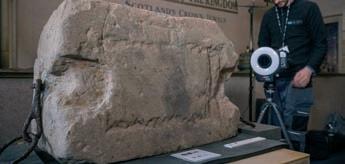
20 Heritage pavers in new public space will reflect Manchester ’s industrial past ROOFING
CHURCH LIGHTING
26 Lighting installation works hand-in hand with restoration project

SOUND & AV SYSTEMS

29 Annual event draws the crowds
29 Industry show has all the latest in AV – and some!

31 AV installers make the (up)grade at Holy Trinity
32 Keeping your congregation in the loop requires regular checks
GILDING & SIGNWRITING
33 Brian’s gilt-edged brushwork adds lustre to commissions both sacred and temporal
WINDOWS & ROOFLIGHTS
34 Conservation rooflights allow period house to become a 21st-century home
36 Specialist glazing units help period buildings stay ahead of the curve

CONSERVATION
38 Wells’s famous medieval clock is restored in time to ‘spring forward’ in March

ACCESS & LIGHTNING PROTECTION
39 Paramount Platforms places biggest ever Hinowa order
41 How bell ringers can help prevent lightning strikes
41 Finding an ATLAS member just got easier
3 www.ecclesiasticalandheritageworld.co.uk COVER
STORY
Cover photo by Chris Stokes
NEWS
Heritage Heroes are honoured for their volunteering 9 Grade Two-listing for world’s first ATM 13 Stone of Destiny reveals more of its secrets 13 Caernarfon Castle project completes 15 ‘At risk’ quartet feature among NCT grantees 15 Nominate a heritage charity for £1,000 award 16 Norwich’s historic Halls set for major refurb IRONWORK & METALWORK 17 Restoration of Darby ’s Great Exhibition fountain nears completion 18 Second ironwork award opens for entries
9
& LEADWORK
year
delivery 22
and heritage projects among the finalists in
Roofing Awards 23 Man found guilty of church lead theft across swath of England 25 CRE’s popularity leads to expansion of floorspace 25 Eurovision song inspires new venue for CRE North CONTENTS Richard Shepherd – Business Development Manager Advertising enquiries: Tel: 07429 516265 Email: richard@dmmonline.co.uk All other enquiries: Tel: 0161 710 3880 Fax: 0161 710 3879 • 61 Lower Hillgate, Stockport, Cheshire SK1 3AW Copyright Ecclesiastical & Heritage World. All rights reserved. No part of this publication may be copied, reproduced or transmitted in any form without prior permission of Ecclesiastical & Heritage World. Views expressed in this magazine are not necessarily those of the publisher. 3DMM Printed in the UK by The Magazine Printing Company Plc www.magprint.co.uk
THE PRODUCT OR SERVICE YOU NEED IN CHURCH & HERITAGE SUPPLIES FROM PAGE 42
21 Training provider looks forward to first
of SAP
Church
UK
FIND
13 17 22 25
38


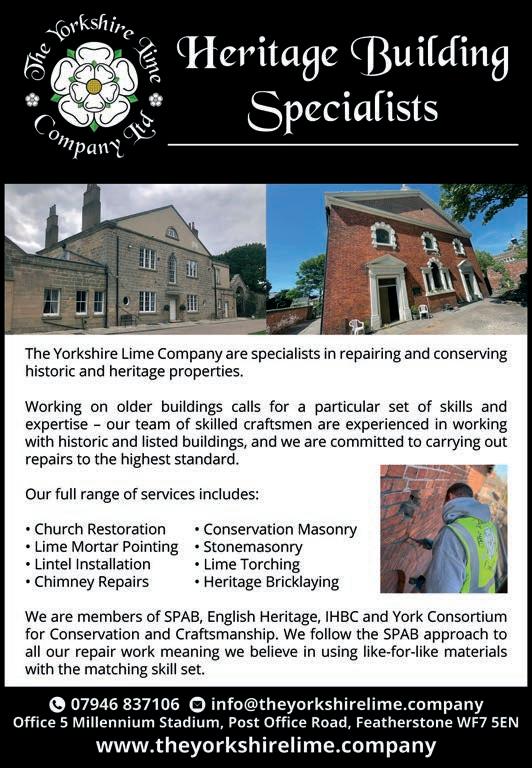
4 www.ecclesiasticalandheritageworld.co.uk
[ AS A TEENAGER I was involved in twinning exchanges with my home town’s twin in South West France. On one visit by my twinning partner we travelled as a family to spend a short holiday in Wales, proudly showing him the castle at Caernarfon, with the plinth and canopy still in place from the investiture of the then Prince of Wales a year or so previously.
Half a century and more later, that same castle has completed a major project to make more of it accessible to everyone. The main gateway has now reopened with rooftop decks and floors, with new visitor interpretation.
• That same Prince of Wales is now King Charles III. His Coronation on 6 May follows many in taking place with the Scottish Stone of Destiny installed inside the throne. The stone’s other name is the Stone of Scone, after the palace near Perth where it was thought to have been made. New research by Historic Environment Scotland has added to evidence that the limestone around Scone is indeed where it originated.
• A couple of years before the Prince of Wales was invested in Caernarfon, Barclays Bank revealed the world’s first cash machine – in Enfield, London. The first customer was the popular comic actor Reg Varney, whose On the Buses show is still to be seen on digital channels.
• Another major player in the finance sector is the Benefact Group. The group is owned by the Benefact Trust, a charitable body that provides millions in grants to charities, particularly Christian charities, and has done since its formation 135 years ago. Their Movement for Good awards have been helping charities across the board. One of the member companies of the group is specialist heritage and church insurer Ecclesiastical, who are encouraging readers of this publication to nominate their favourite ecclesiastical or heritage charities for an award.
• Nothing speaks better to a sense of heritage than an ancient clock – the embodiment of the passage of time that is the stuff of heritage. One of the most famous of Britain’s ancient clocks is the one that graces Wells Cathedral. The clock dates from around 1475 and was feeling its age, until a restoration project has brought it back to life. It began ticking again in time for the ‘spring forward’ to BST in March.
• If anything invokes an English church more than the chiming of the clock, it is the pealing of the bells. Every Wednesday evening the ringing of the bells at nearby St Nicholas’s serenade my neighbourhood as the bell ringers practise their skills.
What most people perhaps do not appreciate is that those same bell ringers are in a unique position to keep an eye on the lightning protection system, as part of it will be anchored to the bell frame. A useful document outlines how the army of ringers that keep an ancient tradition alive can also keep the church safe.
That is not to say, of course, that there is any substitute for a proper inspection and maintenance regime.

• Churches ancient and modern, together with cathedrals and heritage buildings of divers kinds, have seen their internal environment made comfortable over five decades by heating systems installed by Mellor and Mottram. Hundreds of systems have been installed by the company, whose portfolio ranges from Grade One-listed medieval gems to modern worship centres.
One of the churches to benefit from the skills of Stuart Mottram and his team is the Unitarian Church in Todmorden, West Yorkshire. Rescued from redundancy, it stands proud above the town, as can be seen from our front cover. q
Chris Stokes
Editor, Ecclesiastical & Heritage World

5 www.ecclesiasticalandheritageworld.co.uk
GRADE ONE-LISTED CHURCHES FEATURE IN HEATING FIRM’S 50 YEARS
[ A SUCCESSION OF Grade One-listed churches have featured over the years in the portfolio of specialist church heating installers Mellor and Mottram: in fact the company is celebrating its 50th anniversary this year.
In the case of Todmorden Unitarian Church in West Yorkshire –featured on the front cover of this issue – the new and modern system installed by Mellor and Mottram allowed the church to arise from its redundant status and become both a focal point for the local community and a religious centre for the Unitarian faith.

Mellor and Mottram was founded in 1973 as a commercial heating installation company by partners Roger Mottram and Jack Mellor. It
was not long after the company was established that they discovered a talent for installing systems in churches – with all the specialist expertise that involves.
One of the first churches they installed a system for was St Mary’s at Weaverham in Cheshire (pictured opposite top left). That was in the 1970s; and 30 years later the firm returned to replace what had become an outdated system with a new, energy-efficient system.
A family affair
Over
6 www.ecclesiasticalandheritageworld.co.uk
COVER STORY
the years Roger and Jack gave way to Stuart Mottram, Roger’s son, as managing director.
Family association has also been seen in the firm’s customer base. When Mellor and Mottram won the contract for a new system at All Saint’s in Knaresborough, North Yorkshire, in 2015, they were working for the Rev Esther Foss. Esther was the daughter of Rev Bill Foss, for whom Stuart had installed new boilers 30 years previously at his church in Crewe.
As with many firms with substantial portfolios of work in churches, Mellor and Mottram can point to a number of projects in the nation’s cathedrals. Alongside those in Bangor and St Asaph, the firm is particularly proud of its response to an emergency at the Greek Orthodox Cathedral in Birmingham, where a breakdown just before Christmas 2017 led to the Stoke-on-Trent company carrying out the installation of a replacement to enable seasonal celebrations to take place.
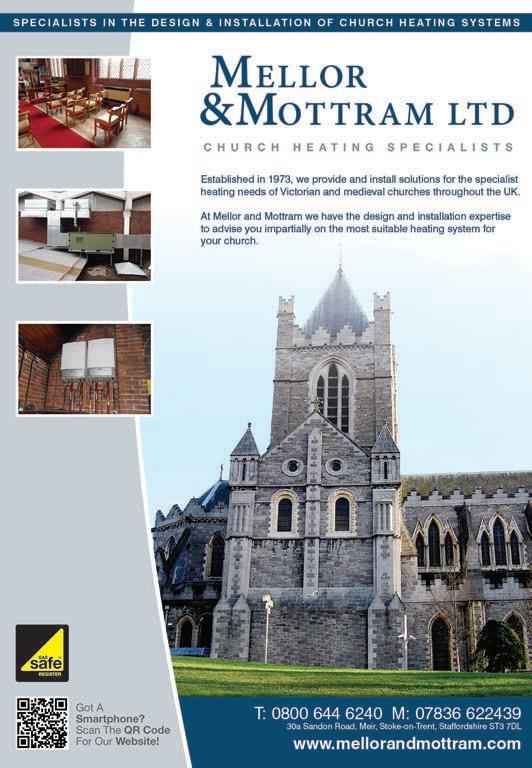
Ancient, modern…and eco-friendly
Other churches that have seen their heating systems renewed by the team at Mellor and Mottram range from medieval gems in South Devon to a modern faith centre in London. Among the more modern churches to benefit from their expertise is St Peter’s in Hednesford, West Midlands (pictured below).

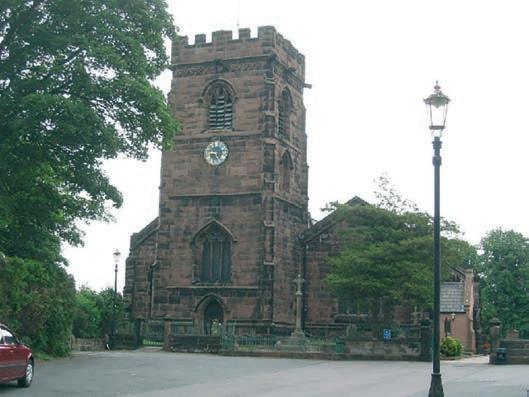
Modern eco-friendly systems have been in the Mellor and Mottram portfolio for some time. Back in 2014 the company completed the installation at the new visitor centre at Denbigh Castle. It comprises both ground source and air source heat pumps (right). Even the plant room housing the system utilised recycled materials.
The castle is one of a number of historic buildings outside of the ecclesiastical sphere that have benefitted from Mellor and Mottram’s specialist expertise. They include an on-going project to upgrade the facilities at Alton Castle in Staffordshire – a stone’s throw from the company’s headquarters in Stoke-on-Trent and next to the world-famous Alton Towers theme park.
What of the future?
Recently, Stuart’s sons Harry and George have stepped up to ensure the firm remains in the family. Stuart continues to cover the country in the search for churches in need of the company’s expertise. Latest in the list is the Church of St Swithun in Cheswardine, Shropshire. Watch this space! q
• For further information call 0800 644 6240 or 07836 622439, alternatively visit the website at www.mellorandmottram.com
The systems Mellor and Mottram install vary as much as the churches they install them in. In some cases a complete system is required, whereas in others an upgrade is the order of the day.
Stuart Mottram explained: “Many of the churches where we have carried out work have had just a simple boiler installation, which may be an oil boiler or gas-fired boiler. The gas-fired option is still possibly the best as the new ones are condensing units.”
Recently, an innovative system of radiant panels has been specified for All Saints’ Church in Harbury, Warwickshire. The science behind the panels reflects the way in which sunshine heats the people and objects it encounters.

7 www.ecclesiasticalandheritageworld.co.uk

HERITAGE HEROES ARE HONOURED FOR THEIR VOLUNTEERING
[TWO HERITAGE HEROES have been recognised for their exceptional service to the UK’s heritage sector. The Heritage Heroes Awards, now in their 13th year, are the Heritage Alliance’s celebration of the outstanding contribution Britain’s heritage volunteers make to society.
Volunteers are vital for the protection of our heritage. From caring for rural heritage sites to engaging the next generation of visitors, volunteers’ skills, passion and commitment are the backbone of the heritage sector.
The awards were presented by Faith Kitchen, customer segment director at insurers Ecclesiastical, which sponsors the awards, at a special Heritage Day event in March. Each of the winners received an Ecclesiastical Heritage Hero 2022 winner presentation plaque. Speakers at the event included Heritage Minister Lord Parkinson, René Olivieri – chair of the National Trust – and Peter Aiers OBE, Master and Chief Executive of The Charterhouse.
The winners of the 2022 Ecclesiastical Heritage Hero Awards were: Ecclesiastical’s Heritage Hero Award – David Kennedy
The award celebrated David’s contribution to Coombe Conduit, an ancient waterworks in Kingston upon Thames, during the past 10 years. David has organised volunteers, engaged and educated visitors, created an online tour to ensure the site was still accessible during the pandemic, and led and inspired many school and student parties.
Ecclesiastical’s Heritage Hero Storyteller Award – Chinatown History Champions
The award celebrated the Chinatown History Champions’ contribution in revealing the neighbourhood’s heritage, engaging visitors through storytelling and contributing to anti-racism work in Chinatown, London, through engaging walking tours.
Commendations were also awarded to recognise outstanding achievements among the other nominees for 2022. For the Heritage Hero Award, a commendation was awarded to the Volunteer Wreck Custodians who look after 64 protected wreck sites. For the Heritage Storyteller Award a commendation went to A Thames Lark for engaging young people with research through an immersive event along the Thames.
Lizzie Glithero-West, CEO of the Heritage Alliance, commented: “It has been truly inspiring this year to see so many examples from across the breadth of our sector of the formidable contribution of heritage volunteers to preservation, engagement and access. David represents so many longstanding volunteers who are leaving an impressive educational legacy.
“Chinatown History Champions showcases how volunteers working together are critical ambassadors of the role heritage has to play to catalyse diverse communities. I’m also delighted that the, often unsung, heroes who monitor and look after our precious wreck sites in this 50th anniversary year of the Protection of Wrecks Act have been recognised for their invaluable contribution here.” q
GRADE TWO-LISTING FOR WORLD’S FIRST ATM
[ THE BARCLAYS BANK in the London suburb of Enfield has been listed at Grade Two by the Department for Culture, Media and Sport, on the advice of Historic England.
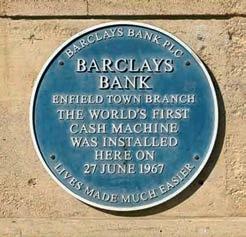

It was the first bank in the world to be fitted with an automated teller machine (ATM) to dispense cash directly to the customer. Its official opening on 27 June 1967 by the actor and comedian Reg Varney drew crowds of spectators.
A red brick building on the corner of a busy high street, it has stone dressings and prominent gables and is topped by a decorative cupola and a small spire. The ground floor is built from stone.
The prototype machine functioned differently to today’s cash machines. The customer inserted a special paper voucher like a cheque that was punched with dots corresponding to the customer’s four-digit PIN. Both a signature and PIN were needed for authentication and if they matched a £10 note was issued. It was a major technological development in both banking practice and the growing use of automation within modern society. q

9 www.ecclesiasticalandheritageworld.co.uk





12 www.ecclesiasticalandheritageworld.co.uk
STONE OF DESTINY REVEALS MORE OF ITS SECRETS
CUTTING-EDGE digital technologies and scientific analysis have revealed more of the story of the Stone of Destiny – also known as the Stone of Scone – the ancient symbol of Scotland’s monarchy which has long held fascination and intrigue due to the mystery of its earliest origins.
Historic Environment Scotland (HES), which cares for the Stone of Destiny on behalf of the Commissioners for the Safeguarding of the Regalia, have carried out the work at the Engine Shed, Scotland’s national building conservation centre, to prepare it for the Coronation of King Charles III at Westminster Abbey.
A new digital 3D model of the stone has been created, allowing the stone to be viewed from different perspectives in higher detail than ever before. That has revealed previously unrecorded markings on the stone’s surface, which have the appearance of Roman numerals. The digital imaging has also improved visibility of the geological features of the stone, such as cross-
CAERNARFON CASTLE PROJECT COMPLETES


[FOLLOWING THREE YEARS of work, the conservation and development project at Caernarfon Castle’s principal gatehouse has been completed – providing access to areas of the castle not seen close-up for centuries.
The £5m investment has seen a rooftop deck installed and new flooring in the gatehouse towers. It also includes the installation of a lift that allows access for all to the upper levels, which Cadw believes is a first for any similar UK World Heritage site. The project will ensure that the castle is welcoming and accessible and continues to make a valuable contribution to the economy of the surrounding area.
A new catering offer, educational and retail spaces, and accessible visitor facilities have also been included in the works, including a Changing Places facility. The scheme is supported by the Welsh Government and by £1.04m from the European Regional Development Fund through the Tourism Attractor Destination Programme, managed by Visit Wales.
Central to the enhancement project is new artistic interpretation, focusing on the theme ‘the hands that built the Castle’. In 1969 the castle was the venue for the investiture of the new King Charles III as Price of Wales.
The project has been delivered by Buttress Architects and Grosvenor Construction, who have re-installed the floor levels of the gatehouse towers, built new steps from the first floor to the new rooftop deck and installed a lightweight glazed glass lift to provide step-free access to the rooftop.
Dawn Bowden MS, Deputy Minister for Arts and Sport, said: “Making our historic sites more accessible is a fantastic – and necessary – way of caring for Wales’s historical monuments for the benefit of present and future generations.
“Enhancement projects like this one ensures that everybody can access Welsh history and learn more about the nation’s heritage. Cadw’s new interpretation will further support this, inviting visitors to discover the lesser-known stories of the castle’s history.” q
bedding, which is indicative of the geological conditions in which the sandstone was formed and which is characteristic of sandstone of the Scone Sandstone Formation. The many tooling marks evident from original working of the stone and areas of wear and tear can now also be seen more clearly, as well as further details of the 1951 repair.
The digital scanning has also been used to create an exact scale 3D-printed replica of the stone, which was used to help preparations for placing it in the Coronation Chair.

Ewan Hyslop, head of research and climate change at HES, explained: “It’s very exciting to discover new information about an object as unique and important to Scotland’s history as the Stone of Destiny.
“The high level of detail we’ve been able to capture through the digital imaging has enabled us to re-examine the tooling marks on the surface of the stone, which has helped confirm that the stone has been roughly worked by more than one stonemason with a number of different tools, as was previously thought.
“The discovery of previously unrecorded markings is also significant; and while at this point we’re unable to say for certain what their purpose or meaning might be, they offer the exciting opportunity for further areas of study.”
The new scientific analysis has also uncovered additional information about the stone, which has enhanced the results of the previous investigation in 1998, when fragments from the stone underwent detailed examination by the British Geological Survey. That work identified the stone as being indistinguishable from sandstones of the Scone Sandstone Formation, which outcrop in the area around Scone Palace, near Perth. q
13 www.ecclesiasticalandheritageworld.co.uk
[

‘AT RISK’ QUARTET FEATURE AMONG NCT GRANTEES
THE FUTURE OF 21 churches and chapels and meeting houses is safe thanks to £351,500 of funding awarded by the National Churches Trust (NCT). Four of the churches being helped are on Historic England’s At Risk Register. Support of £66,500 has been provided by Wolfson Fabric Repair Grants, which support repair work at listed churches in the UK.
Churches being supported in the latest round of grants, announced on 19 April, include the Grade Two*-listed Church of St Mary in central Manchester (pictured) – known as the ‘Hidden Gem’. A £30,000 National Churches Trust Cornerstone Grant and a £6,000 Wolfson Fabric Repair Grant will fund urgent roof and dome repairs.
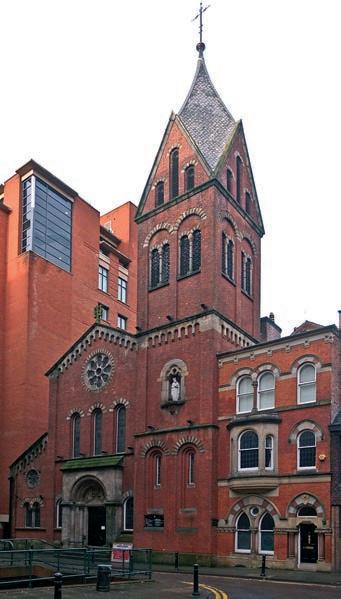
In addition, a £25,000 National Churches Trust Cornerstone Grant goes to St Mark’s church in Dundela, Belfast, which has strong links with the celebrated writer C S Lewis, who was baptised there.
A £25,000 National Churches Trust Cornerstone Grant supports St Agatha’s church in Sparkbrook, Birmingham. The Grade Onelisted arts and crafts style church, one of the finest parish churches in the city, serves a very deprived
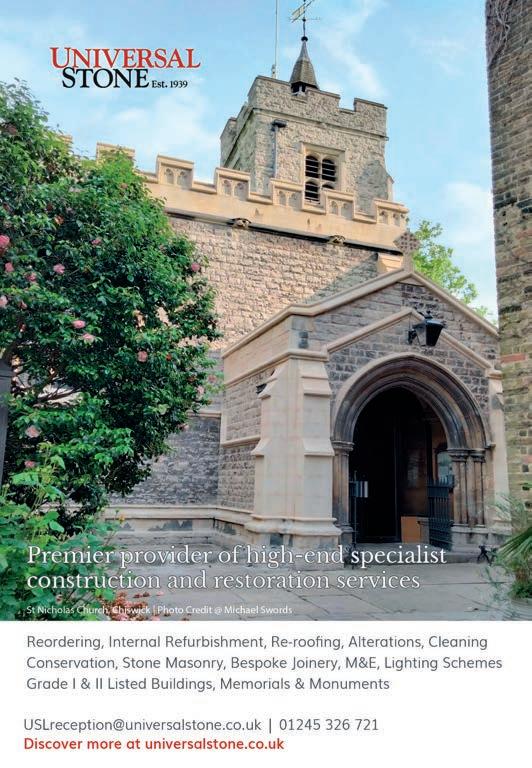
area and the funding will pay for the installation of a servery and a disabled toilet, increasing the range of support it can offer local people.
A £15,000 National Churches Trust Cornerstone Grant and a £10,000 Wolfson Fabric Repair Grant will fund urgent roof and tower repairs to Grade One-listed St Leonard’s Church in Old Warden, Bedfordshire. The ancient church, which dates from the 12th century, includes a set of 22 finely carved oak panels depicting the personal emblems of Henry VIII’s fourth wife, Anne of Cleves.
The trust’s vice president, broadcaster and journalist Huw Edwards, commented: “With many churches facing a struggle to survive, the latest grants are a tremendous boost to congregations, heritage lovers and to many communities in the UK who increasingly rely on the support provided by churches.
“The grants help fund urgent repairs and installing modern facilities including loos and kitchens. This safeguards important local heritage and keeps churches open and in use for the benefit of local people.”
Paul Ramsbottom, chief executive of the Wolfson Foundation, added: “As well as being places
NOMINATE A HERITAGE CHARITY FOR £1,000 AWARD
[APPLICATIONS ARE BEING INVITED for the 2023 round of Benefact Group’s Movement for Good Awards – grants that range from several rounds of £1,000 for nominated charities to a smaller number of grants of £5,000 or £10,000 to be announced later in the year.
Now in their fifth year, the Movement for Good Awards will once again see more than £1m gifted to charities up and down the UK and Ireland.
As the country’s major provider of insurance for heritage and church buildings, Benefact Group company Ecclesiastical is inviting people to nominate their favourite heritage charity to receive one of the £1,000 awards.
Previous heritage charity winners include The Princess of Wales’s Royal Regiment and Queen’s Regiment Museum Maintenance Fund, The Friends of Coldharbour Mill Museum, and Gloucestershire Warwickshire Railway Trust.
Since the awards began, people have submitted an incredible 1.75m nominations and more than 2,000 charities have benefited from valuable donations. The Movement for Good Awards has gifted over £4m since the initiative started.
Winners are drawn at random and the more times a charity is nominated the more chance it has of being selected. The first 150 winning charities will be announced from 1 June, with a further 150 revealed in September and a third tranche in December. The larger grants will be announced throughout the year.
Anyone wishing to nominate a charity for an award should visit www.movementforgood.com q
of worship and buildings of beauty, churches sit at the heart of the community. In many ways they stand between the past and present. We are thrilled to continue our partnership with the National Churches Trust to support the preservation of these significant, much-loved historic buildings across the UK.” q
15 www.ecclesiasticalandheritageworld.co.uk
[
NORWICH’S HISTORIC HALLS SET FOR MAJOR REFURB
[THE HALLS in Norwich is set to benefit from improvements to create an iconic venue which is an active and dynamic cultural centre in the city.
The Halls (pictured) is a multi-use cultural venue owned and run by Norwich City Council, and a Grade One-listed ancient monument. The complex comprises St Andrew’s Hall and Blackfriars’ Hall – former friary church and convent buildings. The buildings passed into public ownership during the Reformation in 1538 and form the most intact medieval friary in England in secular use.

The venue has been used regularly for civic events since 1544, when the first mayor’s feast was held for the inauguration of Henry Fuller. Today, the venue is used for conferences, weddings, concerts and meetings, with different halls available to hire.

Following Norwich City Council’s successful bid for Town Deal funding in 2020, the project to upgrade The Halls received £3.6m.
In March a survey found that urgent works need to be carried out on St Andrew’s and Blackfriars’ Halls within 24 months or they could face closure.
Upgrades to the venue will be achieved by investing in the facilities, including audio-visual equipment and lighting, a major redesign to improve flow and accessibility, a revamp of the outside space and an enhanced café and bar offer.
Essential structural work will also be completed alongside the refurbishment project. They include work to the roof, stained glass

windows and secondary glazing in St Andrew’s Hall.
A spokesperson for Norwich City Council said: “The Halls is a hugely important and unique heritage building that contributes so much to the fantastic cultural offer we have in Norwich. By carrying out these upgrades, we’re excited about the potential to create an iconic venue that will host community and cultural events for many years to come.
“We look forward to sharing our plans in more detail later in the year and will be keeping everyone that makes use of The Halls up to date as the project progresses.” q
16 www.ecclesiasticalandheritageworld.co.uk
RESTORATION OF DARBY’S GREAT EXHIBITION FOUNTAIN NEARS COMPLETION
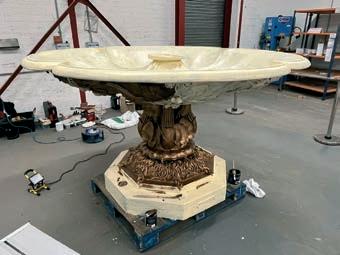
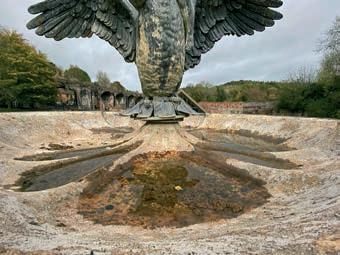
[THE FOUNTAIN known as the Swan and Boy is currently displayed outside the Museum of Iron in Coalbrookdale, Shropshire: just in front of Abraham Darby’s original iron furnaces. It was cast by the Coalbrookdale Company in around 1850, originally for the Great Exhibition of 1851 organised by Prince Albert in Kensington, London. The foundry won an award at the Exhibition. Today it is Listed Grade Two by Historic England.
The Coalbrookdale Company was founded by Abraham Darby in 1709, when he took a lease on the Coalbrookdale Furnace. Importantly, Abraham Darby started to use coke as the fuel in the process of making cast iron, replacing charcoal. That allowed for a huge improvement in the process and the company grew rapidly in size in the early 18th century. In 1779 Abraham Darby III cast and erected the first iron bridge over the River Severn at Ironbridge. It was his son Francis Darby who was responsible for a revival of the business after a downturn at the end of the 18th century, with the development of art castings and decorative ironwork.
The Swan and Boy fountain was designed by the Victorian sculptor John Bell (1811-1895) of Great Yarmouth, Norfolk. It was displayed in the north transept of the Crystal Palace building at the Great Exhibition, in front of a huge pair of ornamental gates made by the Coalbrookdale Company. The fountain was bought after the exhibition by the Wolverhampton Corporation in 1853 for the sum of £150 and was erected inside the new General Market Hall. It remained there until 1881. Sometime around the 1930s the fountain was dismantled and put into storage. It was later ‘discovered’ in a potting shed and returned to Coalbrookdale in 1959.
The company restored the fountain at the foundry and erected it on a concrete base very close to the old furnace in 1959 for the opening of the Museum of Iron. At that time the swan and boy figures were gilded, with the fountain bowl and pedestal being painted green. In 1979, when the current Museum of Iron building was opened, the fountain was moved inside to be displayed against a backdrop of the Crystal Palace.
In 1995 it was moved outside to its current location and was subject to a major programme of conservation. A number of parts had corroded significantly, and several water lily leaves applied to the bowl were renewed. The decision was made to finish the fountain in a bronze colour, with the work being undertaken by a local conservator based in Much Wenlock.
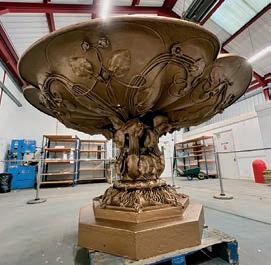
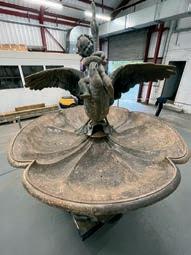
It was erected on a new brick plinth with a sunken pond lined with a rubber membrane. An additional nozzle was added to try to improve the water jet coming from the swan’s beak.
In 2012 there was a further period of repair, stabilisation and repainting, when the fountain was cleaned back to bare metal, removing the 1959 paint finishes. An oil-based paint system was applied to the same bronze finish.
By 2021 the fountain was looking a bit tired with some areas of paint finish beginning to break down, especially where they were exposed to sunlight and water, where some minor rust patches were developing. In addition, limescale had accumulated from the presence of water.
There were also problems with the water supply and a leak in the pond lining. Peter Meehan ACR was appointed by the Ironbridge Gorge Museum Trust to prepare a condition report on the fountain, along with recommendations for its conservation treatment. The trust was able to obtain external funding and commissioned the conservation work at the beginning of October 2022.
In order to make the conservation works easier to carry out – as it was started in the autumn – the fountain was carefully lifted from its brick plinth and transferred to a workshop space behind the Enginuity Museum at Coalbrookdale, a short distance away. The swan and boy figures were removed from the fountain bowl, partly to make them easier to clean and treat and also to allow for repairs to the fixings which had corroded to excess, being made of mild steel.


That also allowed for works to be carried out to the pond and water supply while it was removed. Apart from the fountain bowl, the paint finish was found to be in a good overall condition, still adhering well to the underlying substrate. It was therefore left being cleaned and lightly abraded to allow for repainting.
The paint on the fountain bowl had completely failed, so it was decided to remove it back to bare metal using hand scrapers and rotary wire brushes equivalent to Swedish Standard ST3. Those surfaces were then brush painted with two coats of an alkyd oil-based zinc phosphate primer – Sherwin-Williams Kem-Kromik 489. The nozzle fitted to the swan’s beak was removed and replaced with a simple copper tube – more in keeping with the original design.
It was agreed that the fountain should retain a bronze finish. The previous bronze appearance had been skilfully created by the conservator. For the repaint it was decided to use an oil-based, bronze paint system instead and Ardenbrite was chosen. That system consists of a special primer, metallic paint containing fine metal particles and a clear protective lacquer to help prevent UV degradation. Each of the paint layers was brush applied and left to fully dry. A mix of old penny bronze and a lighter bronze (no 27) were applied to give the fountain a greater depth. The swan and boy were refitted to the fountain bowl with new threaded fixings before the final lacquer coat was applied by spray.
The fountain is now awaiting completion of the work to the brick plinth, pond and water supply, before being returned to public display again in the summer. The conservation work will ensure the fountain continues to be preserved and enjoyed by visitors for many years to come. q
17 www.ecclesiasticalandheritageworld.co.uk
(L-R) The fountain before conservation; close up of the bowl’s corrosion; the bowl after cleaning; and the finish being applied to the bowl after being primed
The bowl and pedestal, and the swan and the boy after the bronze finish was applied
SECOND IRONWORK AWARD OPENS FOR ENTRIES
[THE National Heritage Ironwork Group (NHIG) is inviting entries for its Award for Heritage Metalwork Conservation. Inaugurated last year, the award seeks to recognise and celebrate excellence in ironwork conservation as an inspiration to all.

Submitted work must have been carried out in the past five years, in accordance with current conservation philosophy. Entries can be submitted by anyone closely connected with a project, although the award will be presented to the practitioner who carried out the work. A maximum of three submissions can be made per person or team.
The judges will be interested in the appropriateness of materials and techniques used, the extent to which loss of original fabric was minimised and the quality of the craftsmanship.
A panel of experienced judges drawn from members of the NHIG Council and the Worshipful Company of Blacksmiths Craft Committee will assess the entries. They will visit shortlisted projects, so access to the site must be ensured.
The NHIG will publicise competition entries and outcomes as examples of good practice to inspire others, so entrants must ensure that all permissions have been sought prior to entry and that images have been cleared for use. Applications close on 31 May. Forms and submission instructions are available at nhig.org.uk/nhig-award/
Last year’s inaugural award went to joint winners: Daniel Liggins for his work on the Oakes Park gates in Sheffield and the team of David James (blacksmith), Andrew Harris (architect) and Rob Umney (surveyor), for their conservation of the 20th Century Garden gates at Hampton Court Palace (pictured top right and bottom right respectively).
The NHIG has also published revised dates for its CPD course, Conservation of Architectural Ironwork, in Bath. Originally scheduled for 20-21 April, the course has been put back to 22-23 June. The venue remains the same – the Museum of Bath at Work in the centre of the World Heritage City.


Aimed at both craft practitioners and consultative professionals, the two-day course – led by Geoff Wallis and Bethan Griffiths – provides an introduction to the conservation of historic ironwork. Lectures cover the historical context, the metallurgy of wrought iron and steels, traditional tools and techniques, materials, design and manufacture. They will be complemented by a walking tour and site visit to survey historic ironwork and develop a strategy for its conservation.
The IHBC recognises the course as contributing to mandatory CPD requirements for its members. The course fee, including lunches and course materials, is £250. Booking is via the NHIG website. q

18 www.ecclesiasticalandheritageworld.co.uk
FEATHER STAR MANTLE: A MEMORIAL TO ST CUTHBERT
THAT IS ALSO ‘A KIND OF ROCK STAR’
Sculptor Russ Coleman shares insights into his creation for English Heritage at Lindisfarne Priory


[ I OFTEN TITLE WORKS with a trilogy; they can be taken as a connected title or three separate words, each with a pertinence to the material or subject. In this case Feather Star Mantle has several differing associations.
The base island is carved from Swaledale fossil limestone that is packed full of crinoid fossils from the Jurassic period some 350 million years ago. It can also be read as an island with pertinence to St Cuthbert and inner Farn. The crinoid fossils are where we get Cuddy’s beads from and can be seen in raw form on the uncut sides.
Swaledale fossil stone was used widely from the medieval to the Victorian era, but fell out of fashion during the 20th century. It is from a quarry near Durham run by Britanicus Stone. The modern crinoid has a free-floating counterpart that is known as a feather star; it moves through the water with a mesmerising motion.
The main stone is a basalt erratic from Northumberland. It was once part of the molten mantle of the earth. There is also the mantle of high position and responsibility. The gilded facet on the rear is the remains of a cleft where the

rock was broken and I have gilded it to celebrate its scarring, or its journey from the centre of the earth to the surface, its breaking and its long travels from the far north by glacier.
The feather also references the Cuddy duck, part of St Cuthbert’s flock. The Circle of Frosterly marble that frames the Cuthbert cross completes a trilogy of northern stones.
As above so below
When you look at the black basalt boulder with the multicoloured dots and splashes, with slight background variations, you get a sense of looking at stars or a nebula: a sense of staring back through time to the beginnings of the universe.
Was St Cuthbert a star in the modern sense of celebrity? He was venerated in his time and he assumed great authority and fame – and is still a stellar attraction. His Celtic Christian beginnings and close connections to the earth and wildlife seem to make him a figure for modern times and as relevant now as he was 500 years ago.
With many thanks to English Heritage for this prestigious opportunity. q
19 www.ecclesiasticalandheritageworld.co.uk
HERITAGE PAVERS IN NEW PUBLIC SPACE WILL REFLECT MANCHESTER’S INDUSTRIAL PAST
[MAYFIELD IN MANCHESTER has a rich industrial history and is on its way to becoming a thriving mixeduse community in the bustling city centre. At its heart is the new Mayfield Park – 6.5 acres of green public space on the banks of the River Medlock. Designed by Studio Egret West, the park provides a haven of open space for all to enjoy within a new urban development.
Challenges
“A key part of our approach was to ensure the new park was authentically connected to its industrial past,” explained Duncan Paybody, director of landscape at Studio Egret West, lead landscape architects for the scheme and park designers.
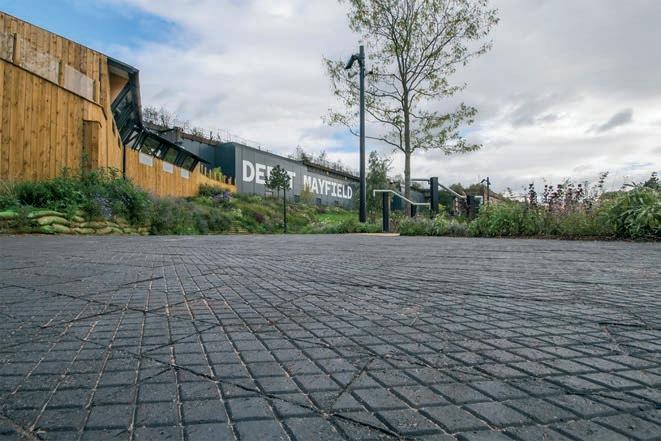
Around 82,000 Ketley Staffordshire blue diamond chequered clay pavers, supplied through Hardscape Products Ltd, have been laid in the park, providing hard landscaping for pathways connecting the sequence of spaces. Their traditional diamond pattern provides extra traction underfoot in wet conditions.

Their specification by Studio Egret West was primarily heritage inspired. The old historic railway depot, with its original Staffordshire blue brickwork, still lies alongside the park and the authentic blue brick colour of Ketley pavers and their traditional character and pattern suited the context of the site perfectly.
The architects were also keen to select a material that would be timeless and not look out of place or dated 100 years on. Made from Etruria
marl clay, Ketley's Staffordshire clay pavers have incredible strength and durability and were often used in Victorian times beside canals and waterways, railways and industrial developments – where you can still find them today: they have passed the test of time. Sustainability was also at the heart of the design for the park and using regionally-sourced materials was therefore another important factor.
The result
The River Medlock has been uncovered and opened up after more than 50 years under concrete, so that it meanders through the park, introducing nature and attracting wildlife to the unique urban space and connecting it to whole of the Medlock Valley.
Many industrial artefacts, recovered from the site, have been scattered throughout the design, carefully placed to blend with the landscape and contribute to the industrial character. A vast public play area has also been designed to fit the historical context, with towers inspired by the archaeological remains of octagonal industrial chimneys found on site. Even down to the planting, the park is true to its industrial roots, with its history of producing purple-dyed fabric prints celebrated with the planting of purple plants – particularly at the park entrances.
The architects have created an authentically Mancunian city-centre park, with a distinct character that is fully grounded in its industrial past. q

20 www.ecclesiasticalandheritageworld.co.uk
Photos courtesy of Hardscape Products
TRAINING PROVIDER LOOKS FORWARD TO FIRST YEAR OF SAP DELIVERY
[SINCE JUNE of last year, specialist lead and hard metals training provider National Construction Training Services (NCTS) has been delivering the Specialist Applied Programmes (SAP) for three disciplines within the sector: Lead and Hard Metals Level 2, Heritage Lead and Hard Metals Level 3 and Heritage Roof Slating & Tiling Level 3.
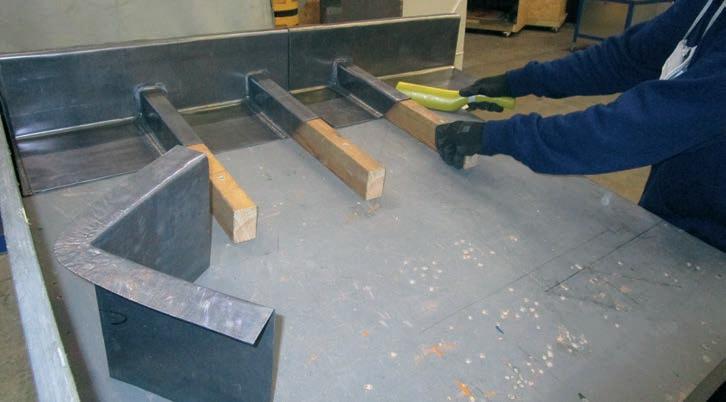

Training is delivered from one of the firm’s two training centres: in Hoddesdon, Hertfordshire, for the lead and hard metals programmes and in Salford, Manchester, for the lead, hard metals and roof slating & tiling programmes. Both training facilities have state-of-the-art full-scale simulated training rigs, together with a full range of tools and equipment and knowledgeable, experienced and qualified tutors.
Level 2 Hard or Soft Metal Roofing Operative
The Level 2 Lead Sheet and Hard Metals programme is an 18-month training and assessment programme, which consists of 30 days attendance at either one of the training centres delivered over six week blocks of five consecutive days in Year 1.
Once the training programme has been completed, NCTS will appoint an assessor to complete the on-site assessment and training (OSAT), which will collate the necessary knowledge and practical evidence.
Level 3 Heritage Hard or Soft Metal Roofing Operative
The Heritage Level 3 Lead Sheet and Hard Metals programme is also an 18-month training and assessment programme, which consists of 45 days attendance at either of the training centres, delivered over nine week blocks of five consecutive days in Year 1.
Once the training programme has been completed, NCTS will appoint an assessor to complete the on-site assessment and training (OSAT), which will collate the necessary knowledge and practical evidence.
Level 3 Heritage Roof Sating & Tiling Roofing Operative
The Heritage Level 3 Roof Slating & Tiling programme is an 18-month training and assessment programme, which consists of 45 days attendance at the Salford training centre, delivered over nine week blocks of five consecutive days in Year 1.
Once the training programme has been completed at the Salford training facility, NCTS will appoint an assessor to complete the onsite assessment and training (OSAT), which will collate the necessary knowledge and practical evidence.
Funding
The Specialist Applied Programmes are funded through CITB, with a contribution of up to £6,000 per candidate leaving a small contribution
from the employer. CITB have also introduced the Travel to Train scheme to help employers with the costs of sending SAP candidates on training, which includes accommodation, travel and meals of up to 80% of the cost, meaning the employer only has to contribute 20%. Further information on grant application is available at www.citb.co.uk q
• For further information and course fees, contact National Construction Training Services (NCTS) at training@ncts.org.uk , tel 01992 801914 or mobile 07864 692513

21 www.ecclesiasticalandheritageworld.co.uk
CHURCH AND HERITAGE PROJECTS AMONG THE FINALISTS IN UK ROOFING AWARDS
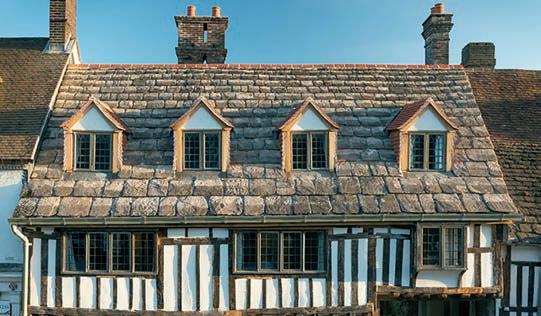


[ON 12 MAY the roofing industry will gather at the InterContinental London – the O2 for the prestigious annual UK NFRC Roofing Awards.
The awards recognise and reward outstanding standards of workmanship, innovation, project management, and health and safety among roofing companies. There are 15 project categories, ranging from slating to rainscreen façades to green roofing – including the specific Heritage and Leadwork categories – with the overall winner across all categories crowned Roof of the Year. Individuals are also recognised for their industry contributions: NFRC’s Young Roofer of the Year and Health and Safety Individual of the Year will be revealed, as will SIG’s Local Hero.
The Industry Choice Award, sponsored by Radmat Building Products, allows the industry to have its say on their favourite project.
James Talman, the CEO of the National Federation of Roofing Contractors,
commented: “The excellent workmanship, project management and problem solving, plus high-quality materials on show through this year’s shortlisted projects is something that the finalists can all be very proud of. We look forward to welcoming colleagues from across the industry to the Intercontinental London – The O2, to reunite with old friends, network and above all celebrate the brilliant work done in roofing and cladding.”
The shortlist for the awards was announced in March. As with past years the list includes a number of both ecclesiastical and heritage projects, in addition to the Heritage category. The shortlist for that category comprises four entries from familiar names: Castor Old Mill House by Claude N Smith Ltd, St Marylebone Church by Mundy Roofing (above left), Derby Market Hall by Longworth Building Services Ltd and Sackville House by Clarke Roofing Southern Ltd (above right).
22 www.ecclesiasticalandheritageworld.co.uk
Traditional leadworking techniques are represented in the Leadwork category. The finalists are Kirby Farm Castle and Somerton Castle NE Tower, both by Matt Timby Ltd, Mamhead House and Castle by NRA Roofing and Flooring Services Ltd (above) and the Drapers Hall by NRA Roofing and Flooring Services Ltd.
Heritage projects in other categories include Jodrell Bank Discovery Centre by LRL Roofing Solutions, in the Green Roofing category, while in the Mastic Asphalt category Battersea Power Station (BriggsAmasco) and The Tower of London Yeomans Keys Club (R J Evans Flat Roofing Ltd, working with IKO Plc) are vying for the honours. A striking lead spire atop The Riverside Pavilion installed by Emerton Roofing (Western) Ltd joins the shortlist for Small Scale Projects < £25K, while Clarke Roofing Southern Ltd’s project at Jane Austen’s House Museum in Hampshire (below) is vying for the Roof Tiling award.
Clarke Roofing Southern Ltd are also in the running for St Luke’s Church in the Roof Slating category. It is one of two ecclesiastical projects in the list, alongside the Convent of Poor Clares of Arundel by SDS Roofing Services Ltd in the same category. q

MAN FOUND GUILTY OF CHURCH LEAD THEFT ACROSS SWATH OF ENGLAND

[A MAN has been given a 24 month community order for his involvement in lead theft from 15 churches across six counties, ranging from Lincolnshire to Wiltshire.
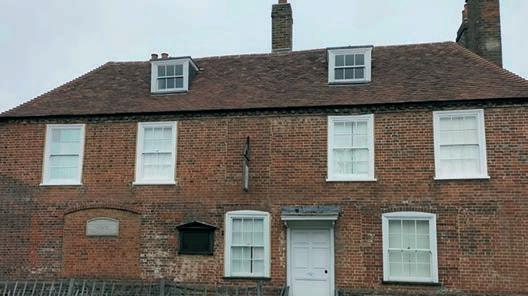
Madalin Gabriel Prundaru, of Ilford, had denied 18 lead theft charges, but following a trial at Lincoln Crown Court a jury found him guilty of all 18 charges after deliberating for over four hours. The trial ran from 20-24 March. He was sentenced on 28 April.
He was part of a group of three of which two others have been previously jailed. All the offences took place during a spate of attacks between May and August 2016, which caused damage estimated at £461,000
Four churches were targeted in Lincolnshire: St Nicholas’s Church in Walcot, which fell victim to thieves twice in late August 2016, St Botolph's in Newton and The Church of St Denys in Kirkby la Thorpe, along with St Andrew’s Church at Witham on the Hill.
A further four churches in Leicestershire fell victim to the raids: St Mary’s at Wyfordby, St Mary’s at Garthorpe, All Saints Church in Beeby and St Peter and Paul’s Church at Sywell, which was struck twice.
The list also included two churches in Oxfordshire – St Andrew’s in Kingham and St Giles’s at Wigginton – two in Northamptonshire –St Margaret’s at Luddington, which was struck twice, and St Andrew’s at Cotterstock – and St Nicholas’s Church in Fyfield, Wiltshire.
Even two churches in the tiny county of Rutland were targeted: St Mary’s at Manton and St Edmund’s at Egleton. q
Martin-Brooks (Roofing Specialists) Ltd
T: 0114 244 7720
E: mb@allroofing.co.uk


W: www.martin-brooks.co.uk
Ross Street, Darnall, Sheffield, South Yorkshire S9 4PU
23 www.ecclesiasticalandheritageworld.co.uk
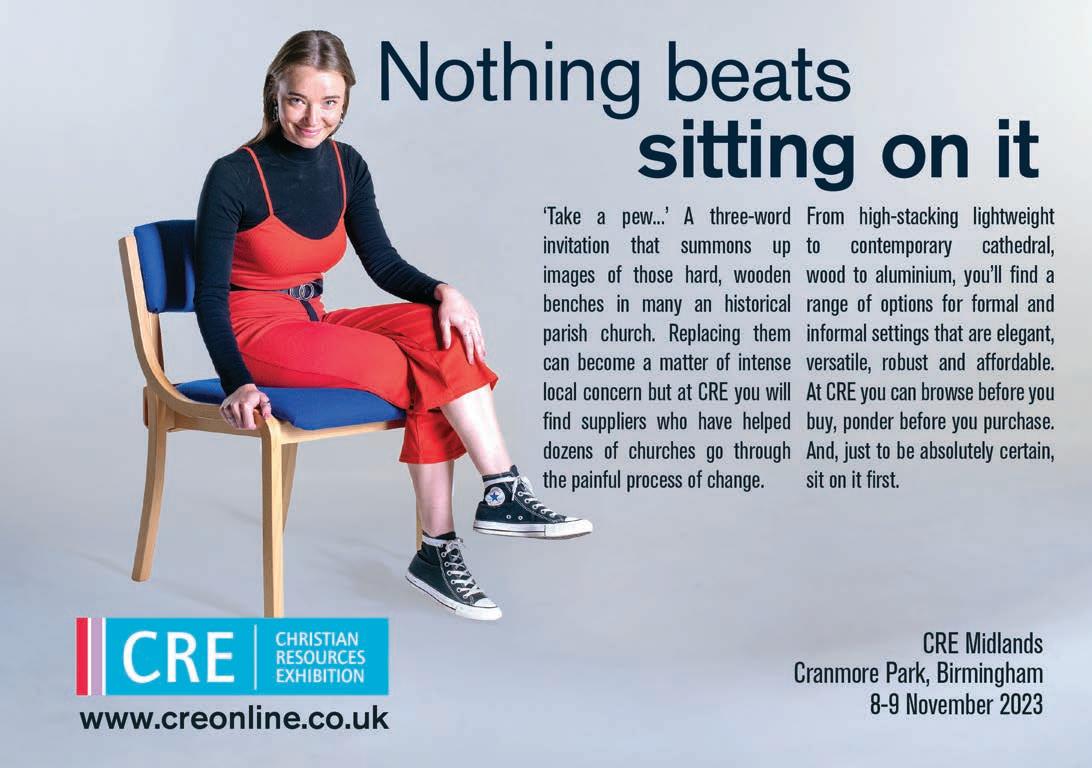

24 www.ecclesiasticalandheritageworld.co.uk
CRE’S POPULARITY LEADS TO EXPANSION OF FLOORSPACE
[STRONG DEMAND FOR STANDS at this year’s Christian Resources Exhibition in Birmingham has led the event’s organisers to expand the exhibition’s floor area. CRE Midlands will take place at Cranmore Park, Solihull, on 8-9 November.
“With several organisations booking space every week, we can now offer positions in the venue’s Diamond Suite,” said CRE event director Brett Pitchfork. “This will enable us to run Mission on the Map, where a number of agencies will come together to focus on mission opportunities and resources, at home and abroad.”
Securing the Diamond Suite also means the event’s talks and arts programme will be increased, with a third presentation area in the body of the hall.

“We are grateful to our loyal exhibitors for supporting us through COVID and beyond,” said Brett. “It is also encouraging to see several new organisations taking the opportunity of reaching key local church leaders throughout the Midlands and beyond.
“The venue is conveniently located in a major conurbation, near the motorway network. At similar centres nearby parking can prove prohibitively expensive for exhibitor and visitor alike – but Cranmore Park has free parking for hundreds of vehicles.”
Although there are still some months to go until the doors open, Brett is encouraging any organisation considering exhibiting to contact the sales team as soon as possible.
Rev Mike Royal, general secretary at Churches Together in England, commented: “I’m delighted CRE is coming to Birmingham. It provides a unique opportunity for church and charity leaders to engage with the widest network of Christian organisations seeking to make a difference at home and aboard. I am looking forward to seeing many people there!”
One of the highlights of the entertainment programme at CRE Midlands will be a performance of Saints Alive, a musical by Birmingham-born
EUROVISION SONG INSPIRES NEW VENUE FOR CRE NORTH
WHEN THE ORGANISERS of CRE heard the lyric in this year’s UK Eurovision entry, ‘Instead, I wrote a song...’, they took inspiration from it. Having had to relinquish the Liverpool venue of CRE North to make way for the competition, instead they moved to Manchester!
CRE owner Steve Goddard explained: “While we wish singer Mae Muller douze points galore, the song continually reminds us how we had to abandon CRE North 2023 when the venue was requisitioned for the contest.”
A year later than originally planned, on 15-16 May next year, CRE North will be the first at the new BEC Arena, just a mile from the Trafford Centre and recently-demolished Event City – the venue of the last CRE North, in 2019.
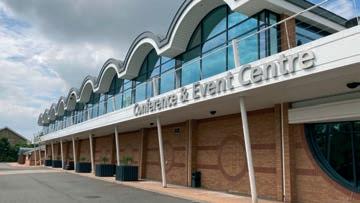
Alongside more than 180 organisations, exhibitors will be in the heart of the North West conurbation, at a venue offering easy access by road, rail and tram. And there’s free parking onsite to make exhibiting and visiting a pleasurable experience.
Stands are going fast: at the time of writing 25% had already been booked, so early booking is recommended. q
maestro Roger Jones. Roger (pictured) will be bringing a Birmingham-based choir to the exhibition for a 50-minute performance of what is his sixth musical. To date he has 24 under his belt.

The musical has been performed in many parts of the world: including a memorable one in Jerusalem in 1983, the first of many trips Roger has made to the country. His vision for musicals began as head teacher at Aston Manor School in 1973. The school choir performed Jerusalem Joy – a performance he wrote around Jesus’s ride into the holy city on a donkey.
Organisations looking to book a stand should contact Carol Malpass on 0161 250 2467; email carol@creonline.co.uk, or James Batterbee on 0161 250 2306; email james@creonline.co.uk. q
• Tickets for the show, at £4 in advance or £3 for groups of three or more, are available from www.creonline.co.uk. Readers of Ecclesiastical and Heritage World can get a FREE ticket. Simply enter the discount code E+HWORLD in the appropriate box
25 www.ecclesiasticalandheritageworld.co.uk
[
LIGHTING INSTALLATION WORKS HAND-IN-HAND WITH RESTORATION PROJECT
[ THE RESTORATION and refurbishment project at the Church of St Mary the Virgin at Holne, on the slopes of Dartmoor in South Devon, was a long-term undertaking. As all involved are well aware, obtaining the necessary permissions and faculty for the medieval, Grade One-listed building took almost a decade. That included securing the funding! But, then again, it had been over 100 years since the last refurbishment – so upgrading the lighting was integral to the whole scheme.
Obviously, the church has undergone major and minor work since it was built in the 13th century and it has been part of the fascinating history of the village for the past 782 years.
The church originally consisted of the central nave and chancel, with transepts and a western tower; but in about 1500 the building was enlarged to include side aisles and arcades. In 1855 the chancel roof was renewed with ornate roof bosses and in the same year the window over the high altar was donated to the parish. A short time later, in 1894, in the north transept a window in memory of Charles Kingsley – the writer, priest and social reformer who is famous as the author of The Water Babies and Westward Ho! – was installed. He was born and baptised in Holne in 1819 during the time that his father was a curate at St Mary’s.
For this latest restoration, project management was the key, as it involved experienced professionals in conservation, electricals, lighting, roofing, plumbing, boilers, plaster and woodwork – to name but a few. It was a complex refurbishment and required closing the church for five months –
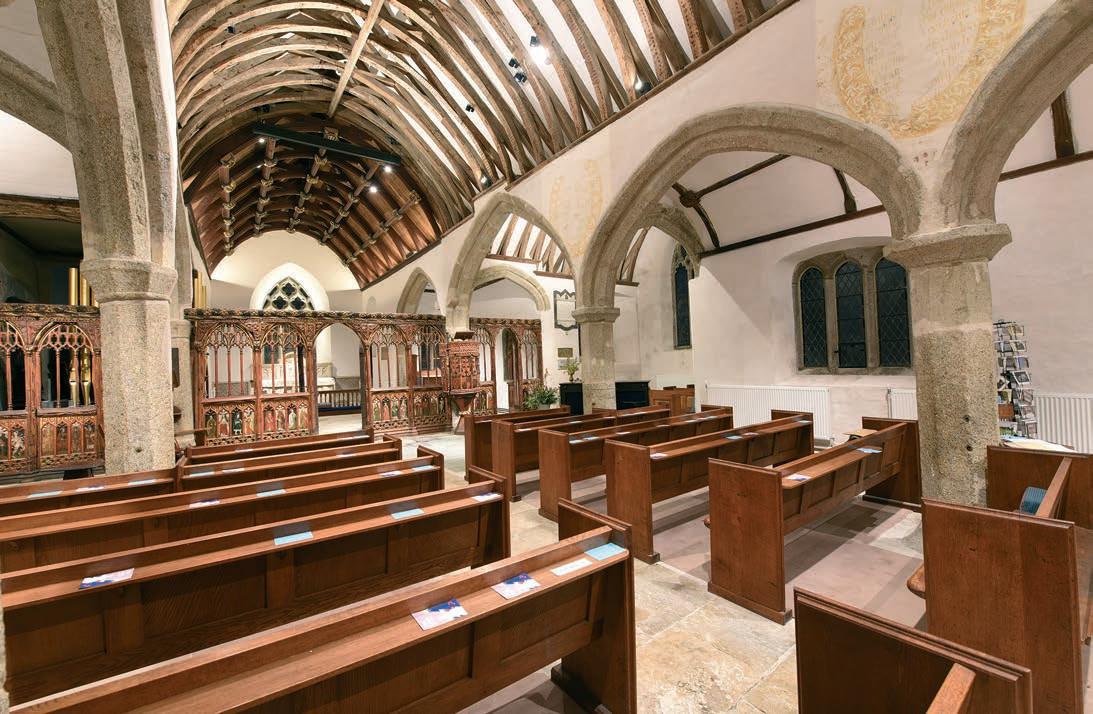
while the congregation prayed at other village locations.
In 2020 a survey of the plaster and painted surfaces in the church was carried out. The result of the survey revealed possible fragments of late 17th or early 18th century text and painting on the walls of the nave arcade.
A further detailed study and report was undertaken in July 2022 once the full scaffold was in place. The charming and ornately painted cartouches with biblical inscriptions have been revealed above the arches in the nave arcade. They were found to be supported by a hair plaster applied onto an earlier lime plaster and were covered in limewash.
The work involved the removal of previous interventions where electrical cables had been inserted and covered with cement. That cement, and red plastic conduit, had facilitated the fitting and fixing of lighting some 60 years ago –unfortunately cutting through the paintings. The four 17th-century cartouches revealed were uncovered and stabilised.
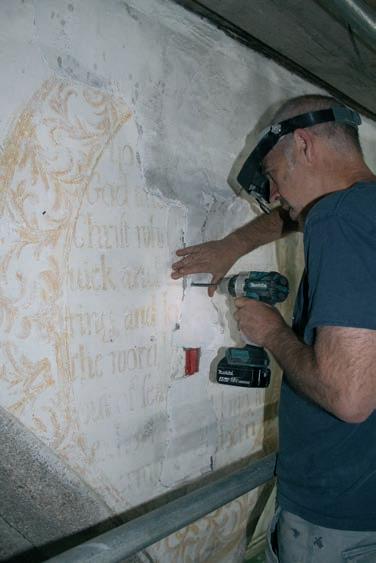
Neil Blake and Che Polley from Anthony J Smith (Gloucester) Ltd first visited the church in 2019 and following further meetings, demonstrations and discussions a new lighting specification was presented to the congregation and PCC. The proposals were then submitted to Exeter DAC, with further guidance from the church architect John Scott.
A completely new, dimmable LED lighting system has been installed, together with an easy-to-control and alter scene setting system, which provides the flexibility to give plenty of
26 www.ecclesiasticalandheritageworld.co.uk
variations to suit the services and activities taking place in the church.
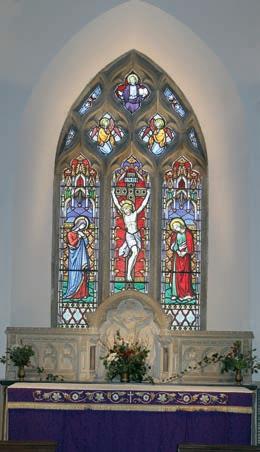
Once the roof was repaired and sealed, the chancel ceiling was next. The wonderful bosses are now highlighted by the new lighting installation.
The rood screen across the nave and aisles dates from 1480. It was described in 1876 as ‘one of the finest in its class in the county’. Conservation was carried out on the screen and its 40 wainscot paintings of saints and martyrs in 2008 and the chalice – or goblet – pulpit in 2015. St Mary’s now features as one of Devon’s Fifty Best Churches, in a book with the same name.

Again, sympathetic lighting installed by Anthony J Smith (Gloucester) Ltd now highlights this remarkable, and wonderful feature (pictured above).
Underneath the ceiling the High Altar needed tender loving care – and sympathetic lighting installed by A J Smith now emphasises both its importance and beauty. The pictures (right) show the altar before and after the new lighting was installed. You could say the
lighting now illuminates the whole chancel.
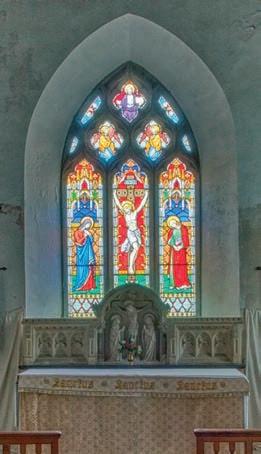
Church Warden Gillian pointed to the importance of team work to the project: “While quite a long process, the overall project has been a great success. The lighting in particular has revealed that the church is greater in size than previously perceived and highlights the many significant features within it. Thanks to A J Smith for their important contribution and teamwork – it was and is very much appreciated.”
The church has not only resumed its services, but is also now a community venue for the village. A recent community event was attended by over 80 local people.
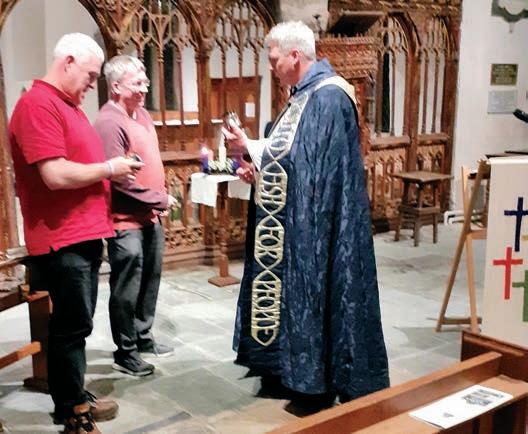
Che from A J Smith added: “It is always a privilege to be involved with projects like this, especially when the new lighting really enhances all the features that were already present and just waiting to really be seen. Following completion of the works we were invited to attend the first service back in the church and received a great deal of praise and positive comments from the parishioners and local community.” q
• For further information call 01453 825 130, email the team at enquiries@anthonyjsmith.co.uk or visit www.anthonyjsmith.co.uk
27 www.ecclesiasticalandheritageworld.co.uk
Che Polley and Peter Hill of Anthony J. Smith (Gloucester) Ltd are pictured receiving a gift of Devon honey from the Rt Rev Mark Rylands, now Rector of St Mary the Virgin, at the re-opening dedication service.




28 www.ecclesiasticalandheritageworld.co.uk
ANNUAL EVENT DRAWS THE CROWDS
[
MARCH SAW the latest AGM, conference and exhibition of the Institute of Sound, Communications and Visual Engineers (ISCVE), the trade body of the sound and AV profession. ISCVEx 2023 was held at Coombe Abbey Hotel in Coventry. Those attending were treated to three dynamic seminars, an exhibition showcasing the latest industry developments and a networking evening with dinner and a live band.
Events kicked off on 21 March with the ISCVE Members’ Day and AGM, followed by an engaging presentation from Alex Krasnic BEng(Hons) MSc FIOA MInstSVCE. Members were joined later by others at the networking dinner and party, which lasted late into the night.
Wednesday saw industry-leading seminars, where industry experts discussed topics including emerging technologies, new business models, trends in customer experiences and more.
Paul Dougherty MInstSCVE, managing director of Blaydon Communications commented: “It’s been years since I’ve attended the exhibition and this year has made me realise what I’ve been missing. Relaxed environment where you can catch up with industry friends and see lots of new products. Superb presentations from knowledgeable peers about interesting subjects – and a free lunch, too! Looking forward to 2024 already!”
INDUSTRY SHOW HAS ALL THE LATEST IN AV – AND SOME!
[
PLASA FOCUS LEEDS – the northern regional show for the whole of the entertainment technology industry – returns to the Royal Armouries from 9-10 May; and alongside the friendly show floor, visitors can attend back-to-back seminars and workshops, led by respected industry leaders. Vectorworks, the programme sponsor, will present two sessions on their market-leading solutions: Vectorworks ConnectCAD will walk visitors through audio-visual workflows, then Production Design for Sky Sports Boxing will unpack the full design journey for a major TV event.

Lighting
Lighting professionals can gain both creative and technical insights at the show. Renowned lighting designer Durham Marenghi will present Lasers as Light, showcasing his work on the Leeds Year of Culture Opening Ceremony, the World Cup Opening Ceremony in Qatar and the ‘hidden’ New Year’s Eve celebrations in London. Elsewhere, ETC will present The Balance of Power, sharing considerations for new LED fixtures and how power control infrastructure could save your show.
Audio and audio-visual
Audio professionals can hear from HOLOPLOT in their session The Future of Storytelling, answering the question ‘what does immersive really mean?’ The session will explore the answers by taking a look behind the scenes of London’s latest immersive venue, Lightroom, and its opening show David Hockney: Bigger & Closer (not smaller & further away)
Electrical and technical safety
James Eade will present two sessions at the show, taking a deep look at electrical safety. In PAT is Dead! Long Live ET! James will provide a clear explanation of PAT testing; and in BS7909: 2023 – What's New? he will share his expertise on equipment such as RCDs, battery storage and generator earthing.
The ABTT will also dive into the latest technical developments with their Technical Standards for Places of Entertainment, sharing all the amendments since 2022. Plus, production manager Tom Goode will explore the relationships between safety, health, continuity and resilience. q
• Browse the programme at www.plasaleeds.com
29 www.ecclesiasticalandheritageworld.co.uk
q

AV INSTALLERS MAKE THE (UP)GRADE AT HOLY TRINITY

[LAST YEAR, Holy Trinity Church in Knaphill, Woking, commissioned Creative Audio-Visual Solutions (CAVS) to complete a major audio, visual and performance lighting upgrade.
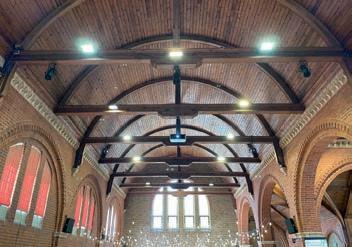
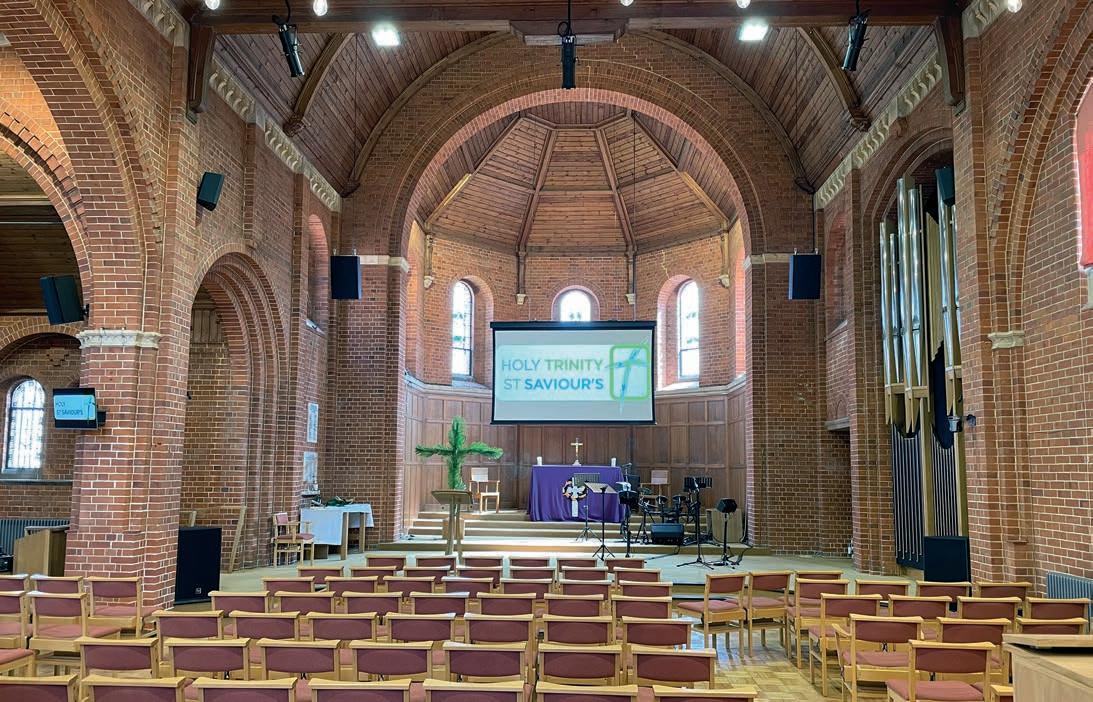
The audio system features an Allen & Heath SQ6 digital mixing console with iPAD control over a new, managed wi-fi or network infrastructure for main operators – and also for musicians to adjust their monitor levels independently. The mixer provides over 40 inputs, via digital stagebox expansion on the dais, with the ability for different service settings to be stored and recalled along with direct audio recording.
The existing speaker system required upgrading to provide vastly improved music reproduction, along with better clarity and intelligibility throughout the congregation. A system based on Electrovoice EVC speakers – a front suspended pair for uniform coverage and a delayed pair to reduce audio ‘doubling’ as sound travels the length of the room – is supported by compact Electrovoice EVF 15-inch subwoofers for true full range reproduction.
For audio system management – room equalisation and individual speaker optimisation – an Allen & Heath AHM-32 audio matrix was specified: with the additional ability via a remote touch panel to change speaker configuration for different meetings at the rear of the church.

The audio system is completed by Bluetooth music connectivity on the dais, together with a console Denon media player and Sennheiser radio microphones with antenna distribution and charging stations.
For the visual upgrade, a new Epsom 8,000 lumen laser projector provides high image quality in all lighting conditions. Supplementary 32-inch Viewsonic LED displays provide additional coverage for the side transept and for dais ‘confidence’ display.
Both the in-house visual system and online service stream are managed from one system, via a Roland V8-HD production mixer. Eight HDMi inputs, with the ability for keying (text over images) and dual picture-in-picture, means the system is highly flexible while being easy to use. Two PTZoptics motorised cameras provide image capture within the church, controlled via a network joystick to provide both manual control and simple preset position access – from the altar, lecterns, font, etc – at the touch of a button. A Datavideo streaming server provides direct access to YouTube for online streaming without the need for additional computer software.
Dais lighting quality needed to be improved, not only to provide a better focal point within the church but also to raise camera quality, certainly in darker ambient conditions. Multiple Chauvet EVE LED fixtures provide dais coverage with high-frequency output helping to avoid camera or screen flicker. In addition, internal shuttering vastly reduces any lighting spill onto the projection screen. Redundant DMX/Artnet control infrastructure provides the ability to add further lighting fixtures, including motorised heads, in the future.
Finally, CAVS designed a bespoke operating console to blend with the church aesthetics while providing a tactile and secure working environment for up to three operators. q
• For an on-site installation consultation or advice on the right equipment for your church contact CAVS on tel 01707 649355, email sales@cavsolutions.co.uk or visit www.cavsolutions.co.uk Local references are available upon request. Alternatively, you can ‘Like’ them on Facebook (Cavsolutions) for the latest installation case studies and product news.
31 www.ecclesiasticalandheritageworld.co.uk
KEEPING YOUR CONGREGATION IN THE LOOP REQUIRES REGULAR CHECKS
[PLACES OF WORSHIP are becoming increasingly aware of the need to be accessible to people with hearing loss – to be both inclusive of their communities and to meet equality legislation. Assistive listening systems such as hearing loops offer those who wear a hearing aid or cochlear implant the ability to receive clear sound so they can feel fully part of every service. However, the commitment to worshippers doesn’t end there: installation is only the first step. After that, staff or volunteers need to make sure the system continues to offer sound to the required standard.
As a recent article from the Diocese of London highlighted, many churches have hearing loop systems but do not know if they are working well – or at all. And if they’re not functioning correctly, then equality laws aren’t being complied with. It isn’t just in the spaces of worship: hearing loops, together with ceiling or portable microphones, can and should also be used in meeting spaces used by the community.

Once a hearing loop system has been installed its low energy use means it can – and should be – left switched on to amplify the sound from the microphone on the pulpit or those of the band performing. It means worshippers don’t have to declare their hearing loss and can access the service discreetly and equitably.
Many buildings upgrade their sound systems, re-organise layouts or repurpose the spaces they have. Cabling can get damaged and power sources turned off, or amplifiers for the loop system, known as loop drivers, become unplugged.
Any public building undergoing renovation must be compliant with the standard BS-8300; that standard provides detail and advice on where and how to integrate assistive technology in the built environment.
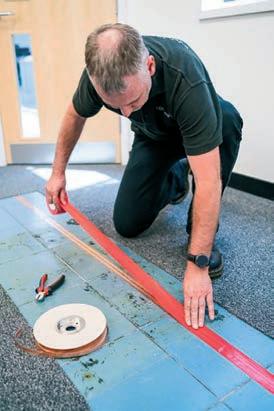
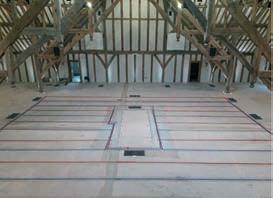

Once any changes are complete the loop can be checked with a loop listener – a small hand-held device with headphones. The user will be able to tell if the loop is working and get an indication of the signal strength. It allows staff to do a simple check each month and have confidence their loop is working.
What it can’t replace, though, is regular maintenance by a qualified engineer. Their equipment will give a more accurate indication of the loop’s performance, which needs to meet the internationally recognised IEC 60118-4 standard.
Engineers will also be able to check cabling, microphones and the ‘health’ of the overall system; and – most importantly – they will know how to resolve any issues that have arisen.
Signage is also an important part of maintenance checks. The blue ‘ear’ signs are a key part of the hearing loop system, but they can get taken down during redecoration or refurbishment and not put back up again.
The signs let people know a loop system is available and prompt users to switch their hearing device to the ‘T’ position, activating the in-built telecoil to receive the signal transmitted by the loop.

It is intensely frustrating for anyone visiting a place of worship to not be able to hear what’s going on, and even more so when a system designed to remove that frustration doesn’t work. It can mean worshippers or community members look to another venue that better meets their needs. q
• To find out more visit www.contacta.co.uk
32 www.ecclesiasticalandheritageworld.co.uk
BRIAN’S GILT-EDGED BRUSHWORK ADDS LUSTRE TO COMMISSIONS BOTH SACRED AND TEMPORAL
PRETTY MUCH ALL OF US will have passed by commercial properties or visited premises with exquisite signage and wondered at the craftsmanship involved in their creation. In particular, if the work involved gilding the artistry is all the more admirable.
What most of us will not know is that the same artistry involved in the representation of those treasured local names is to be seen in the restoration projects of some of our historic buildings. Those of us who live in the North of England will be particularly familiar with the work of Brian the Brush Ltd – a traditional hand-painting signwriting company based in Yorkshire and Cheshire, but which also serves the whole of the UK.
The firm is named after its eponymous founder. Brian himself has been in the signwriting business for over four decades, during which time he has expanded his expertise to include the gilding of artefacts both religious and secular: from the coats of arms of companies with Royal Appointments to architectural gems and historic palaces, including the Tower of London.
Brian’s story echoes the story of the classic craftsman. After spending his teenage years at art college his career took him straight on to undertake a long apprenticeship in the art of traditional signwriting and gold leaf gilding. During his time as an apprentice in Bradford, West Yorkshire, he was privileged to work alongside – and learn from – highly-skilled artisans in all the crafts associated with signwriting and gilding, including reverse glass gilding and architectural gilding. They taught him well!
Brian the Brush’s business (for that is the nickname he had acquired) rapidly grew and he gained an excellent reputation in his field, initially concentrating just on the Yorkshire area but eventually gaining a nationwide reputation as one of the country’s finest traditional signwriters and gold leaf gilders.
Brian is proud to be a true artisan of the ‘old school’ traditional skills and values associated with hand signwriting and gold leaf gilding. He is a genuine, time-served, traditional signwriter and gilder, and also something of an original and one-off himself.
Among the many projects Brian is proud to showcase is the gilding of the altar pieces and Christ figure at St Patrick’s RC Church in Durham. Having impressed with previous work at the church, Brian the Brush Ltd were favoured with the additional gilding work at St Patrick’s.
The project (pictured) included the gilding of decorative wooden fretwork panels that are positioned behind the altar. They were originally plain wood, but the addition of the gold leaf creatively enhanced the panels, making a spectacular focal point of the altar.
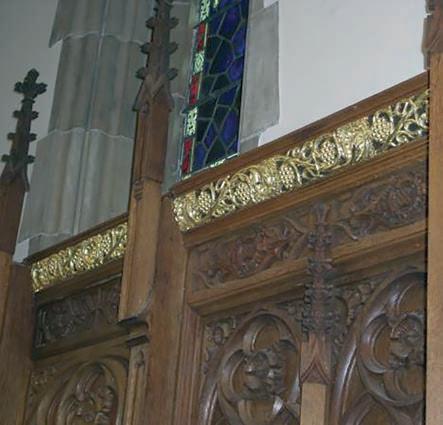
Restoration work also included the gold leaf gilding of the entire statue of Christ and other areas of the cross, the re-painting and
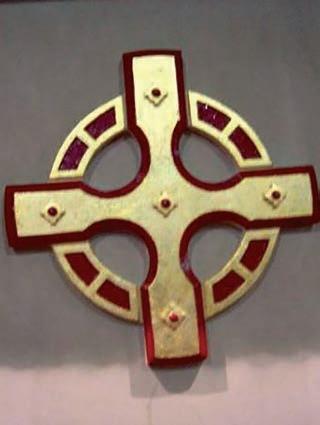
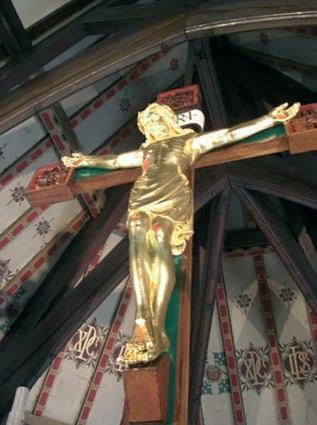
varnishing of the cross and sections at each end of the cross.
Brian the Brush Ltd is a family-run business led by a man with outstanding artistic ability and a team packed with enthusiasm for the art of traditional signage and gilding. No project is viewed as too big, small, or difficult. q
• Visit www.brianthebrushuk.com to browse their portfolio, which shows off just some of the wide range and diversity of the team’s artistic skills.

33 www.ecclesiasticalandheritageworld.co.uk
[
CONSERVATION ROOFLIGHTS ALLOW PERIOD HOUSE TO BECOME A 21ST-CENTURY HOME
[THE OLD COURT HOUSE is located on a large farm in the West Midlands which is under private ownership. The farm had been purchased with a number of outline consents for the conversion of the various farm buildings into habitable dwellings and staff accommodation; but those consents were all linked to the repair of one particular building on the site: The Old Court House.
The house, which had been derelict for over 30 years, was close to collapse and on the Buildings at Risk Register. It was home to bats, newts, slow worms and badgers and its location on the edge of several Sites of Special Scientific Interest presented further challenges. In the words of the architect, it was ‘more ecosystem than building.’

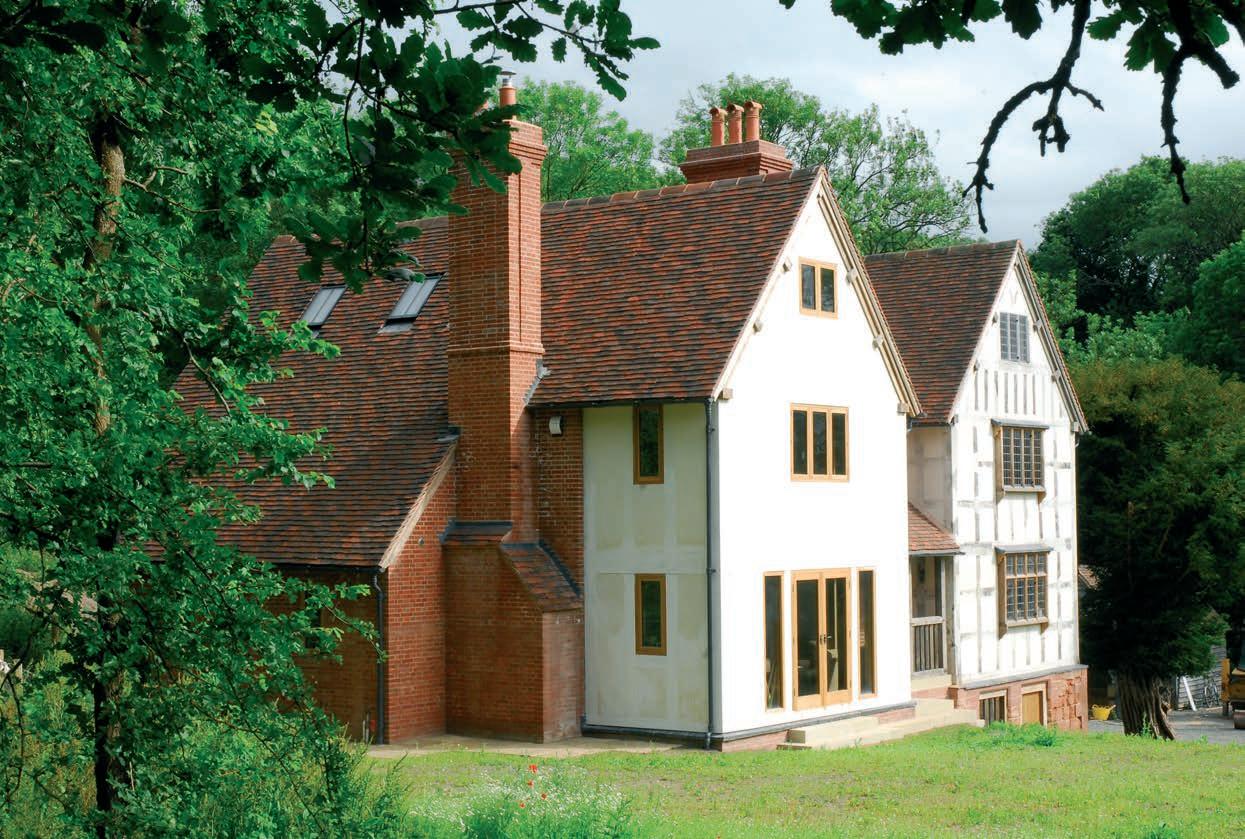
The local planning authority had placed a Section 106 agreement on the property, detailing its rescue from dereliction, and was preparing to increase its listing status to Grade One, as it was rumoured to be a hunting lodge gifted by Queen Elizabeth I to Robert Dudley, 1st Earl of Leicester. Dating carried out during the course of the works confirmed that the building had been constructed in phases between 1526 and 1613.
Consisting of a central brick chimney stack, a stone base and a badly deteriorated oak frame, which was unstable on one side of the house and completely gone from the other, there were only limited clues as to the structure’s original design and features. The timber-and-lath frame had survived but showed signs of distress.
Harrison Brookes Architects undertook a complex archaeological investigation to try to establish what had been there and put together a plan of works which would recover as many elements of the original structure as could be safely put back together.
A team – which included among others the private owner, the architects, Speller Metcalfe Contractors and specialist engineers, geologists, archaeologists and ecologists – worked closely to bring the house back to life using a range of conservation skills. The objective was always to preserve the character of the building by working with the structure rather than against it. Specially-made components were employed, such as bricks and tiles and Hempcrete – a hemp-lime material which can be used to add thermal performance to medieval timber frame buildings.
34 www.ecclesiasticalandheritageworld.co.uk
The Old Court House, Worcestershire, post renovation project (top); and Clement Conservation rooflights (above) – photos courtesy of Harrison Brookes Architects
Often the team involved had to learn ancient techniques, such as how to mix and apply wattle and daub to the internal walls; but they were combined with the state-of-the-art modern technologies needed to construct the 2km road, 7km water pipe and new reed beds for filtration that were also required for the site.
Clement Windows Group were approached to supply roof windows from the Clement 3 range of conservation rooflights, in a tile profile because of their adherence to these traditional values. Modern replicas of Victorian originals, Clement conservation rooflights are particularly suitable for listed buildings or heritage projects. Available in two profiles for tile or slate roofs, each rooflight is silicone fronted, giving the appearance of conventional putty glazing, but offers many of the advantages of a 21st-century building product. When tested for air, wind and rain performance they achieved a BFRC Window Energy Rating of A+.
• Clement Windows Group manufactures an innovative range of steel windows, doors and screens. Recognised as specialists in conservation work for both private residences and commercial projects, the company’s standard range of conservation rooflights is available from stock within a few days. The range can be viewed at clementwindows.co.uk/gallery-rooflights
For more information contact 01428 643393, email info@clementwg.co.uk or visit www.clementwindows.co.uk


As Rhys Brookes from Harrison Brookes Architects commented: “This Grade Two-listed building was in a dilapidated state and required meticulous and painstaking reconstruction. The inclusion of Clement’s conservation rooflights helped us to stay true to the original character of the property, whilst also meeting the demands of Building Regulations.”
Today, The Old Court House has been remodelled into a stunning 4/5 bedroom house and is a wonderful balance of the old and the new. The restored wing pays tribute to the original materials, while the new wing provides an opportunity for contemporary interior design.
The project has won numerous awards, including a RIBA Conservation Award, and was shortlisted for Grand Designs’ House of the Year in 2018. q

35 www.ecclesiasticalandheritageworld.co.uk
The Old Court House before work began – photography by Roy Hunt
Interior of The Old Court House following renovation – photo courtesy of Harrison Brookes Architects
SPECIALIST GLAZING UNITS HELP PERIOD BUILDINGS STAY AHEAD OF THE CURVE

[CURVED-IN-PLAN GLAZING UNITS have been around for some time, but over recent years there has been a significant surge in their popularity. The curved shape matches both contemporary and heritage aesthetics, creating a sense of flow and continuity. Internally, they help to enhance a feeling of light and spaciousness.
Contemporary design with traditional elegance
For conservation and listed properties curved-in-plan units have a number of benefits. They can be designed to match the exact shape and size of the existing windows – a key consideration when it comes to preserving the historic and architectural integrity of the building – and as well as providing a sympathetic replacement for the original windows, curved-in-plan units provide enhanced thermal and acoustic performance. Curved-in-plan units
help to reduce energy bills and lower the property’s carbon footprint. However, while these units are increasingly popular, the specialist knowledge and expertise required to create and fit them is in short supply.
Precision and quality
Storm Windows, based in the West Midlands, is one of the few companies in the UK that have the expertise to supply secondary glazing for curvedin-plan units. Their approach to creating the units is underpinned by a commitment to precision and quality. The process begins with a survey of the windows. A paper template is used to create an exact copy of the curved window, then an MDF template is made in the workshop. That template is sent to the glass company to create the curved glass. The glass that is created is then cut to size by hand in the Storm Windows
36 www.ecclesiasticalandheritageworld.co.uk
workshop. Throughout the process there is close attention to detail, ensuring that the windows are created to fully meet the requirements of the customer and the particular installation.
That highly-developed expertise means that Storm Windows is in demand across the country. Over recent years they have been involved with a range of prestigious projects that required curved-in-plan units. A shining example of that is K1 Knightsbridge (above centre).
K1 Knightsbridge
K1 Knightsbridge is a prestigious mixed-use development located in the Royal Borough of Kensington and Chelsea, London. The development is made up of commercial, residential and retail space and comprises 35 luxury apartments, high-end retail shops and office space.

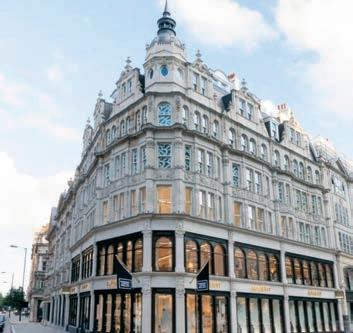
As part of the development, Storm Windows was commissioned to provide bespoke curved-in-plan units for 33 of the 60 windows that were being installed. The company’s expertise in creating slimline units with the curved-in-plan design was crucial in meeting the demanding specifications of the project.
The developer Skanska went through a number of different window designs before settling on a final choice. Storm Windows developed an innovative approach that saw the secondary glazing integrated into the structure of the original window. That means that, when the window is opened, the entire window, including the secondary glazing, opens simultaneously. The original ironmongery of the window is then fitted over the secondary glazing fittings, ensuring the required thermal and noise reductions are achieved.
In addition to the K1 Knightsbridge project, Storm Windows has provided curved-in-plan units for other high-profile projects, such as the Bury Street project for the Crown Estate in London (main pic opposite and below) and The Pick Building in Leicester (above right). In both cases, contemporary expectations in terms of insulation, energy efficiency and noise reduction were all met without compromising the overall aesthetics of the buildings.
Warm homes with traditional aesthetics
A perennial issue for owners of period properties is how to create warm, energy-efficient homes without compromising the valued aesthetics of the building. Curved-in-plan units are an increasingly popular choice with homeowners looking to improve the insulation and energy efficiency of their properties.
The owner of a property in Scotland wanted to add extra warmth and insulation to an alcove (above left) that had beautiful views but was too cold and draughty to linger in, particularly in the winter. Storm Windows was tasked with adding three curved-in-plan units to the alcove’s windows, including two slimline units and a horizontal sliding unit for the centre window.

The team at Storm Windows was able to design and install the units in a way that not only improved the thermal insulation and reduced draughts but also enhanced the aesthetic appeal of the space. The new glazing units matched the curve of the original windows and were finished with safety film to ensure the safety of the occupants. As a result, the alcove is now a warm and cosy space that can be enjoyed throughout the year – no matter the weather conditions outside.
For those seeking advice about curved-in-plan units, their practicality and the impact they can have on energy bills, the experienced team at Storm Windows is always happy to help. q

• For more information, advice or to book a survey call 01384 636365 or email sales@stormwindows.co.uk

37 www.ecclesiasticalandheritageworld.co.uk
WELLS’S FAMOUS MEDIEVAL CLOCK IS RESTORED IN TIME TO ‘SPRING FORWARD’ IN MARCH

WELLS CATHEDRAL’S famous external clockface, on its north transept – which it was feared would be irreparable if left in its current state – has been repaired and restored with a programme of work carried out by Cliveden Conservation and other heritage specialists.
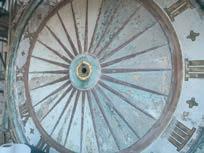
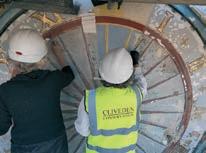



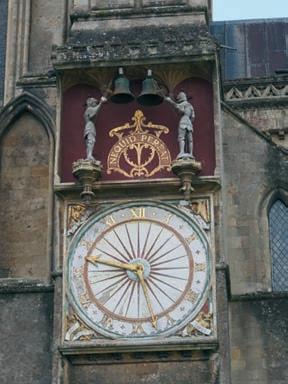

Since its fabrication in around 1475 the clock has undergone many phases of redecoration and repair. With further deterioration becoming more apparent, specialist conservators were contracted at the end of 2022 to carry out crucial repair work to preserve as much as possible of the historic painted layers and fabric of the clock.
Cleaning, consolidation, repair, replacement and refinishing of each element of the clock has now been completed and the scaffold removed. Cliveden Conservation worked in collaboration with the Cathedral Chapter, cathedral architect Nick Cox, the Cathedral Fabric Commission for England (CFCE) and Historic England throughout the process. The new decorative scheme, prepared by Nick Cox and approved by the Chapter, CFCE and statutory consultees, is based on the original to replace the mid 20-century interpretation. It was partially informed by samples taken during extensive paint analysis to establish the many historic decorative schemes: the most recent was carried out in 1959.
A large amount of rare historic paint, which was discovered during the cleaning process, has been consolidated and protected. Irreparable stonework has been successfully replaced with newly-cut stone –including the creation of crenelated tops to the pedestals and the pendant hanging beneath the jack.
During the works the clock motion behind the dial was removed to be restored by Timsbury Clocks and the timber jacks were transported to Swan Farm Studio for repair and repainting. The bells were cleaned of corrosion by Matthew Higby and Co. All the counterweights for the jacks have been de-rusted and stabilised; and new stainless-steel rods have been installed to operate the jacks. The bells have been turned by a quarter-turn to prevent excessive wear when struck by the poleaxes.
The freshly restored 15th-century clockface is now set to tell the time for many years to come – with the work being completed in time for the start of British Summer Time – thanks to expert collaboration and sensitive restoration.
Jackie Croft, chief operating officer and Chapter clerk, said that the Chapter is thrilled with the results: “The exterior clock of Wells Cathedral draws visitors from near and far; and its bells, struck by the jacks on the quarter-hour, mean that everyone in the vicinity of the cathedral is in no doubt of the time of day! The repair and restoration of this iconic clock has been a long-held aspiration of the Chapter and it is very grateful for the generous donations from the Dickinson Family Charitable Trust, the Worshipful Company of Clock Makers, plus others. The work is a wonderful example of skilled heritage craftspeople coming together to deliver the project and ensures that the clock will be seen and heard by generations to come.” q
38 www.ecclesiasticalandheritageworld.co.uk
[
(L-R) The medieval clock before and after conservation; removal of the jacks for repairs and redecoration; and the newly restored jack back in its rightful place
Top to bottom: During cleaning of the dial; samples for agreement on colour; during redecoration
PARAMOUNT PLATFORMS PLACES BIGGEST EVER HINOWA ORDER
[PARAMOUNT PLATFORMS LTD, one of the UK’s leading spider rental specialists, has placed its biggest ever order for Hinowa spider lifts supplied by Access Platform Sales (APS).

Paramount Platforms is taking nine tracked spider booms in a deal worth over £1m.
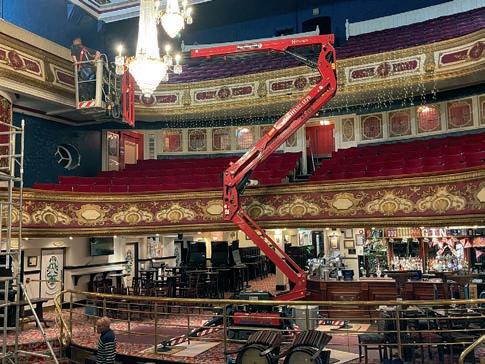
They include bi-energy, lithium battery and diesel versions of the new Hinowa Lightlift 40.18 Performance IIIS.
With a working height of 42m and maximum outreach of 17.5m, it is the biggest platform the Italian manufacturer has ever produced.
The advantages of Hinowa spider booms, in accessing confined spaces and working across low load-bearing surfaces, means they are widely used across many sectors, including building surveying and maintenance, construction, tree management, and a wide range of electrical and mechanical engineering installation and maintenance projects.

Paramount Platforms director Lee Kerr said: “We’ve had Hinowa platforms in our fleet since our inception 13 years ago because they are the best and most user-friendly tracked spider available on the market.
“Our customers like using them because they’re so simple and smooth to operate. We’re strengthening our fleet across the working height range because of customer demand.
“We’re looking forward to being the first rental company in the UK to supply the Hinowa Lightlift 40.18. What’s so good about it is that it has exactly the same operating system as all other Hinowa platforms.
“It may give much greater working height, but it’s still one touch of a button to level the platform and away
you go. So our customers will have zero difficulty in using it.”
Steve Couling, managing director of APS, the UK and Ireland authorised distributor for Hinowa, said: “We’re delighted Lee and his team – and their customers – have such confidence in Hinowa spider booms.
“Their performance characteristics are matched by excellent quality and reliability. Also, the range of lithium electric options means Hinowa platforms are more sustainable than ever.”
Paramount Platforms has invested in two bienergy Hinowa Lightlift 15.70 spider lifts, with diesel and 110v electric power.
It is also taking two bi-energy versions of Hinowa’s new Lightlift 18.80 platform (lithium battery and diesel), and two bi-energy Hinowa Lightlift 20.10s (diesel and 110v mains electric).
The order has been completed by a bienergy (diesel and 110v mains electric)
Hinowa Lightlift 26.14 spider boom lift and a
bi-energy (lithium battery and diesel) Hinowa Lightlift 33.17.
All the highly-compact platforms provide an unrestricted platform capacity of 230kg, with the 40.18 giving an extra 70kgs within a restricted outreach of 16m.
Continued strong rental demand for spider booms across a range of sectors, including telecommunications installation and maintenance and building inspection, informed Paramount Platforms investment choices.
Lee Kerr said: “Lithium bi-energy spider lifts are growing in popularity because clients want the flexibility and efficiency of indoor and outdoor working in one machine.
“Also, being able to use nearly silent, zero emissions platforms is ideal for working in residential areas.
“The clients of the contractors we work with are also increasingly expecting a contribution to their zero carbon strategies.
“It all means we can see our big Hinowa machines, like our Hinowa Lightlift 33.17s and Hinowa Lightlift 40.18, are going to be very popular.”
The Hinowa Lightlift 18.80 spider boom, another new model, can be towed on a 3.5t trailer using a van or 4x4 car in all configurations, including as lithium bi-energy and full lithium platforms.
It is also the first Hinowa tracked spider to have cables and tubes stowed inside the boom, and has the option of being supplied with radio remote control. q
• For further information visit the website at www.accessplatforms.co.uk
39 www.ecclesiasticalandheritageworld.co.uk
39 www.ecclesiasticalandheritageworld.co.uk
The following companies are all specialists in Lightning Protection Systems:

Direct Strike Ltd

Lightning Protection and Earthing Solutions
• Lightning Protection
• Inspection & Maintenance
• BSEN 62305:2011
• Consultancy & Design Services
• Supply & Installation
• Earthing Systems
• Height Safety & Fall Arrest Systems

• Surge Protection
Head Office: 01461 337951 Rep of Ireland: +353 45 913 129
E: enquiries@directstrike.co.uk W: www.directstrike.co.uk
18 Canberra Road, Gretna, Dumfriesshire, Scotland DG16 5DP
Central High Rise Limited Industry specialist in fitting both new and retrofit lightning conductor systems to all types of buildings and structures.
T: 0115 958 7637
E: info@centralhighrise.co.uk

W: www.centralhighrise.co.uk
Central House, Thoresby Avenue, Sneinton, Nottingham NG2 3GA
Cloud to Ground Ltd

Lightning Protection and Earthing Specialists
Our designers are equipped with the accredited knowledge and over 15 years experience to provide:
• Design
• Installation
• Bespoke risk assessment
BS EN62305 Accredited

• Survey
• Test and maintenance
• Surge protection
T: 07498 339466 E: enquiries@ctglp.co.uk
W: www.ctglp.co.uk

18 Cranford Avenue, Macclesfield SK11 7DJ
Lightning Strike Ltd

Lightning Protection and Earthing Specialist for Churches and Historic Properties

• Earthing Systems

• Surge Protection
• Safe Strike ESE Systems
• Lightning Conductor Testing
• Earthing System Testing
• Soil Resistivity Testing
T: 01158 752686 M: 07581 266493
E: info@lightningstrikeltd.co.uk
W: www.lightningstrikeltd.co.uk
452 Watnall Road, Hucknall NG15 6FQ
Horizon Specialist Contracting Ltd







With over 30 years experience our in-house design team are trained and certified to the current British & European Standards BS EN 62305:2011 for Lightning Protection Systems and BS 7430:2011 for Earthing.
• Lightning Protection Systems and Surge Protection Design



• Testing and Inspection surveys


• Steeplejack maintenance



• Fall arrest safety systems

T: 0115 965 7400 E: sales@horizonsc.co.uk W: www.horizonsc.co.uk
Unit 7, Burma Road, Blidworth, Nottinghamshire NG21 0RT
• Lightning Conductor Engineers
• Steeplejacks • Flagpole Specialists
• High Level Access
Providing lightning protection and steeplejack services since 1978.

• Churches
• Cathedrals
• Schools
• Hospitals
• High Rise Office Blocks
• High Rise Residential Blocks
• Towers
• Sports Centres

A C Wallbridge & Co Ltd

T: 01722 322750 E: office@wallbridge.uk W: www.wallbridge.co.uk

Unit 7, Centre One, Lysander Way, Old Sarum, Salisbury SP4 6BU
G & S Steeplejacks Ltd



Over 30 years experience in the Design & Installation of Lightning Protection Systems.
• Annual Testing
• Inspection & Maintenance
• Surge Protection
• Height Safety Systems
Churches, Schools, Hospitals, Universities, Colleges
T: 01761 437796 M: 07974 184449
E: graham@gnssteeplejacks.co.uk W: www.gnssteeplejacks.co.uk
Unit 3, Bath Business Park, Peasedown St John, Somerset BA2 8SF

40 www.ecclesiasticalandheritageworld.co.uk 40 www.ecclesiasticalandheritageworld.co.uk
HOW BELL RINGERS CAN HELP PREVENT LIGHTNING STRIKES
[IT IS IMPOSSIBLE to overstate the importance of churches having their lightning protection systems inspected regularly by a qualified expert. At the same time there are opportunities for church users to keep a weather eye open for possible issues with the system.

One group of regular users who may not spring immediately to mind as ‘lightning vigilantes’ are the church’s bell ringers. That’s according to a document by Alison Hodge on behalf of the Stewardship and Management Workgroup of the Central Council of Church Bell Ringers.
“Ringers probably do not think that lightning protection has much
Wiltshire Steeplejacks

and Lightning Conductor Engineers
We specialise in:
• Lightning protection systems
• BS EN 62305 & BS 6651
• Earthing and resistivity testing
• High maintenance work
• All rope access work
• Flagpoles
• Full architectural surveys & cover meter surveys
T: 01225 761330 M: 07973 397770
E: paul.silk@wiltshiresteeplejacks.co.uk W: www.wiltshiresteeplejacks.co.uk
44 Eastbourne Road, Trowbridge, Wiltshire BA14 7HW
‘connection’ with the bells that we ring,” she writes. “However, in many towers, particularly those with a metal bell frame, the lightning conductor should be electrically bonded (ie connected) to the bell frame, at one or more points.”
She explains that, if a metal bell frame is not connected to a lightning tape, the lightning may strike through the tower and the ‘path of least resistance’ is likely to be via the frame onto damp bell ropes – through wired connections if the bells have simulators, or through the clock hammer linkages to the mains electrical supply of the electric winders.
“A lightning conductor should create a safe electrical path for the charges and so prevent fires, masonry falls, electrical shocks, damage and failure of electrical equipment in the church,” she writes.
“In addition, the churches where we ring often now contain electronic systems, so power connections to them need surge protection devices to protect the electronics from charges that may be induced in the cables.”
How ringers can help
She points out that bell ringers are in a unique position to spot defects in a lightning protection system while they are in or around the tower.
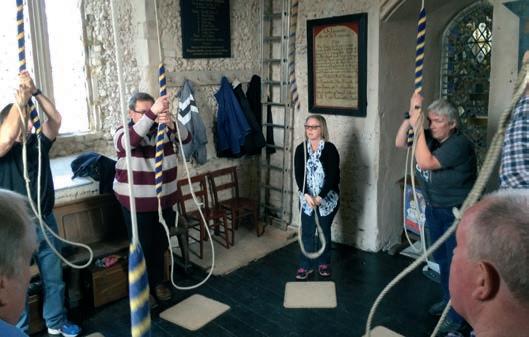
Testing & Installation
E: contact@harrisonlp.co.uk
T: 01325 464464 W: www.harrisonlp.co.uk
2 Lakeland Estate, Faverdale North, Darlington, County Durham DL3 0PX
Cuttings
The UK’s largest independent Lightning Protection & Earthing contractor



Design, installation and maintenance
• Lightning Protection
• Surge Protection
• Earthing Services

• Height Safety Services
Offices in London, Sussex, Essex and Bristol.
T: 020 8371 0001
E: info@cuttings.co.uk W: cuttings.co.uk
10-12 Arcadia Avenue, Finchley Central, London N3 2JU
Lightning Protection Services

North(Head office): 01461 800323

South: 01582 511036 N.E: 01914 661145
E: info@lightningconductor.co.uk
W: www.lightningconductor.co.uk
South West Lightning Protection

T: 07807 334441
E: south@lightningconductor.org
W: www.lightningconductor.org
Airport Business Centre, 10 Thornbury Road, Estover, Plymouth PL6 7PP
“Regrettably,” she adds, “the high price of metals such as copper makes lightning conductors attractive to metal thieves and this may result in loss or damage to the conductor.”
Even a small break or loss of connection to the ground may make a lightning conductor useless, so if a bell ringer notices anything that concerns them, they should alert the church wardens.
The document reiterates the importance of having the lightning protection installed, inspected periodically and maintained by specialist contractors.
“Lightning conductors should never be disconnected or damaged in any way. While any work is underway in the tower, adequate lightning protection must be maintained.” q
FINDING AN ATLAS MEMBER JUST GOT EASIER
[ATLAS, the Association of Technical Lightning and Access Specialists, has launched an updated version of its member directory. The association, which represents specialists in the field of lightning protection, as well as steeplejacking companies, has redesigned its directory to make finding members online easier.

Launching the new-look directory, ATLAS’s Justin Oxenham wrote: “Using an ATLAS member gives you all the assurances you need. Every new member faces a rigorous application process and they’re then monitored every year to ensure continuing compliance. In the unlikely event of an issue with the work completed, you can also speak with ATLAS for assistance in resolving the matter.
“Finding an ATLAS member is now simpler than ever. Our new member directory is super user-friendly, with options for sorting and filtering to help you find the most suitable member for your project.” q
41 www.ecclesiasticalandheritageworld.co.uk 41 www.ecclesiasticalandheritageworld.co.uk
ANTIQUE FURNITURE RESTORATION
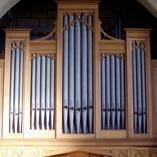


ARBORICULTURAL CONSULTANTS


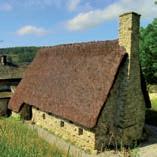



ARCHIVE & CONSERVATION STORAGE
ARCHITECTS



42 www.ecclesiasticalandheritageworld.co.uk
BELLS
BOOK & PAPER CONSERVATION

BRICKS

ASBESTOS MANAGEMENT


BATHROOMS
BUILDING CONSERVATION & RESTORATION




43 www.ecclesiasticalandheritageworld.co.uk
CARVERS – MASTER CARVERS ASSOCIATION

CHURCH FURNITURE
DAMP SPECIALISTS









CLOCKS
DISABLED ACCESS
DISASTER RECOVERY

44 www.ecclesiasticalandheritageworld.co.uk
ENVIRONMENTAL MONITORING


HYMNODY
JOINERY
EXHUMATION SERVICES




HEATING SPECIALISTS





45 www.ecclesiasticalandheritageworld.co.uk DISPLAY PRODUCTS & WORKSHOP FURNITURE










46 www.ecclesiasticalandheritageworld.co.uk LANDSCAPING
LEADED LIGHTS
LEADWORKERS – LCA MEMBERS
LIGHTING
LIGHTNING PROTECTION
G & S Steeplejacks Ltd







Over 30 years experience in the Design & Installation of Lightning Protection Systems.



• Annual Testing
• Inspection & Maintenance
• Surge Protection
• Height Safety Systems
Churches, Schools, Hospitals, Universities, Colleges
T: 01761 437796 M: 07974 184449
E: graham@gnssteeplejacks.co.uk W: www.gnssteeplejacks.co.uk
Unit 3, Bath Business Park, Peasedown St John, Somerset BA2 8SF
Wiltshire Steeplejacks and Lightning Conductor Engineers
We specialise in:

• Lightning protection systems
• BS EN 62305 & BS 6651
• Earthing and resistivity testing
• High maintenance work
• All rope access work
• Flagpoles
• Full architectural surveys & cover meter surveys



T: 01225 761330 M: 07973 397770
E: info@wiltshiresteeplejacks.co.uk W: www.wiltshiresteeplejacks.co.uk
44 Eastbourne Road, Trowbridge, Wiltshire BA14 7HW
47 www.ecclesiasticalandheritageworld.co.uk
Lightning Strike Ltd

Lightning Protection and Earthing Specialist for Churches and Historic Properties


• Earthing Systems
• Surge Protection
• Safe Strike ESE Systems
• Lightning Conductor Testing
• Earthing System Testing
• Soil Resistivity Testing
T: 01158 752686 M: 07581 266493
E: info@lightningstrikeltd.co.uk

W: www.lightningstrikeltd.co.uk
452 Watnall Road, Hucknall NG15 6FQ
• Lightning Conductor Engineers
• Steeplejacks • Flagpole Specialists
• High Level Access
Providing lightning protection and steeplejack services since 1978.


• Churches
• Cathedrals
• Schools
• Hospitals
• High Rise Office Blocks
• High Rise Residential Blocks
• Towers
• Sports Centres

A C Wallbridge & Co Ltd



T: 01722 322750 E: office@wallbridge.uk W: www.wallbridge.co.uk

Unit 7, Centre One, Lysander Way, Old Sarum, Salisbury SP4 6BU

& LIME PLASTERERS



Testing & Installation
E: contact@harrisonlp.co.uk
T: 01325 464464
W: www.harrisonlp.co.uk
2 Lakeland Estate, Faverdale North, Darlington, County Durham DL3 0PX

Lightning Protection Services

North(Head office): 01461 800323


South: 01582 511036 N.E: 01914 661145
E: info@lightningconductor.co.uk

W: www.lightningconductor.co.uk
Direct Strike Ltd

Lightning Protection and Earthing Solutions
• Lightning Protection
• Inspection & Maintenance
• BSEN 62305:2011
• Consultancy & Design Services

• Supply & Installation
• Earthing Systems


• Height Safety & Fall Arrest Systems




• Surge Protection

Head Office: 01461 337951 Rep of Ireland: +353 45 913 129
E: enquiries@directstrike.co.uk W: www.directstrike.co.uk
18 Canberra Road, Gretna, Dumfriesshire, Scotland DG16 5DP
South West Lightning Protection

T: 07807 334441
E: south@lightningconductor.org
W: www.lightningconductor.org
Airport Business Centre, 10 Thornbury Road, Estover, Plymouth PL6 7PP
LIVE STREAMING

48
www.ecclesiasticalandheritageworld.co.uk
LIME
METALWORK

ROOFING


ORGANS

FTMRC

PAINTING & DECORATING


SOUND, AUDIO VISUAL & LOOP SYSTEMS






49 www.ecclesiasticalandheritageworld.co.uk
PUBLIC RELATIONS & MARKETING









50 www.ecclesiasticalandheritageworld.co.uk
ISCVE
STAINED GLASS
STONE & STONE SUPPLY


TRAINING
WINDOWS
WOOD PROTECTION & RESTORATION









51 www.ecclesiasticalandheritageworld.co.uk




















































































































































































































































